
State of California
Department of Technology
Project Requirements Development
Instructions
Statewide Information Management Manual – Section 170B
August 2016

California Department of Technology 2
SIMM Section 170B
Project Requirements Development Instructions August 2016
Table of Content
1. Introduction ................................................................................................................................ 4
1.1 Overview ............................................................................................................................. 4
1.2 Background ......................................................................................................................... 4
1.3 References .......................................................................................................................... 5
1.4 Requirements Evolution ....................................................................................................... 6
1.5 Project Glossary .................................................................................................................. 6
2. Requirements Development within the Project Approval Life Cycle ............................................... 7
2.1 STEP 1: Project Business Objectives Verification .................................................................. 7
2.1.1 Step 1 Inputs/Outputs .................................................................................................... 7
2.2 STEP 2: Mid-Level Solution Requirements Development ....................................................... 8
2.2.1 Step 2 Inputs/Outputs .................................................................................................... 8
2.2.2 Mid-Level Solution Requirement Template ..................................................................... 9
2.2.3 Mid-Level Solution Requirements Types ........................................................................ 9
2.2.4 Mid-Level Solution Requirements Management ............................................................ 12
2.3 STEP 3: Detailed Solution Requirements Development ....................................................... 13
2.3.1 Step 3 Inputs/Outputs .................................................................................................. 13
2.3.2 Detailed Solution Requirements Template .................................................................... 13
2.3.3 Requirement Specifications ......................................................................................... 14
2.3.4 Categorizing Requirements ......................................................................................... 18
2.3.5 Classification Framework ............................................................................................. 19
2.3.6 Detailed Solution Requirements Management .............................................................. 20
3. Requirements Development Planning ........................................................................................ 21
3.1 Roles and Responsibilities.................................................................................................. 21
3.2 Identify Project Stakeholders .............................................................................................. 23
3.3 Eliciting Stakeholder Requirements..................................................................................... 24
3.4 Define Stakeholder Requirements ...................................................................................... 26
3.4.1 Define Constraints ....................................................................................................... 26
3.4.2 Define Operation and Support Activity Sequences ........................................................ 26
3.4.3 Identify Human-System Interactions ............................................................................. 27
3.4.4 Specify Critical Qualities .............................................................................................. 27
3.5 Analyze Stakeholder Requirements .................................................................................... 27
3.5.1 Analyze Elicited Requirements..................................................................................... 29
3.5.2 Resolve Requirements Problems ................................................................................. 29
3.5.3 Provide Feedback ....................................................................................................... 30
3.5.4 Validate Requirements ................................................................................................ 30
3.5.5 Document Requirements ............................................................................................. 30
3.5.6 Maintain Requirements Data........................................................................................ 31
4. Requirements Management ...................................................................................................... 31
4.1 Relationship to other Project Management Plans ................................................................ 31
4.2 Roles and Responsibilities.................................................................................................. 32
4.3 The Requirements Management Process ........................................................................... 34
4.4 Establish a Controlled Requirements Repository ................................................................. 34
4.4.1 Requirements Repository ............................................................................................ 34
4.5 Create Requirements Baseline ........................................................................................... 35
4.5.1 Load Requirements Baseline ....................................................................................... 35
4.5.2 Identify and Tag Requirement ...................................................................................... 36
4.5.3 Set Requirement Attributes .......................................................................................... 36
4.6 Perform Requirements Traceability ..................................................................................... 36
4.7 Managing Requirements Change........................................................................................ 36
4.7.1 Requirements Change Impact Assessment .................................................................. 37
4.8 Updating Baseline Requirements ........................................................................................ 41

California Department of Technology 3
SIMM Section 170B
Project Requirements Development Instructions August 2016
4.8.1 Modification Update..................................................................................................... 41
4.8.2 Addition Update .......................................................................................................... 41
4.8.3 Deletion Update .......................................................................................................... 41
4.9 Requirements Traceability .................................................................................................. 42
4.10 Repository Updates............................................................................................................ 46
Table of Figures
Figure 1: Project Approval Lifecycle (PAL) .......................................................................................... 6
Figure 2: Stage 2 Alternatives Analysis Mid-Level Solution Requirements Template............................. 9
Figure 3: Stage 2 Mid-Level Solution Requirements (SIMM Section 19B.1) ........................................ 10
Figure 4: Stage 3 Detailed Solution Requirements Template ............................................................. 14
Figure 5: Category Group Levels ...................................................................................................... 19
Figure 6: View of Requirements Analysis .......................................................................................... 28
Figure 7: Modified Requirements Assessment .................................................................................. 38
Figure 8: Added Requirement Assessment ....................................................................................... 39
Figure 9: Delete Requirement Assessment ....................................................................................... 40
Figure 10: V-Model Example ............................................................................................................ 43
Figure 11: Fan-out and Fan-in Example ............................................................................................ 44
Figure 12: Horizontal Traceability Example ....................................................................................... 45
Table of Tables
Table 1: SMART Objectives Verification ............................................................................................. 7
Table 2: Mid-Level Solution Requirements ........................................................................................ 11
Table 3: Detailed Solution Requirements Examples .......................................................................... 16
Table 4: Roles and Responsibilities of Requirements Development ................................................... 21
Table 5: Example Stakeholder Groups ............................................................................................. 23
Table 6: Example Elicitation Approach.............................................................................................. 25
Table 7: Roles and Responsibilities for Requirements Management .................................................. 32
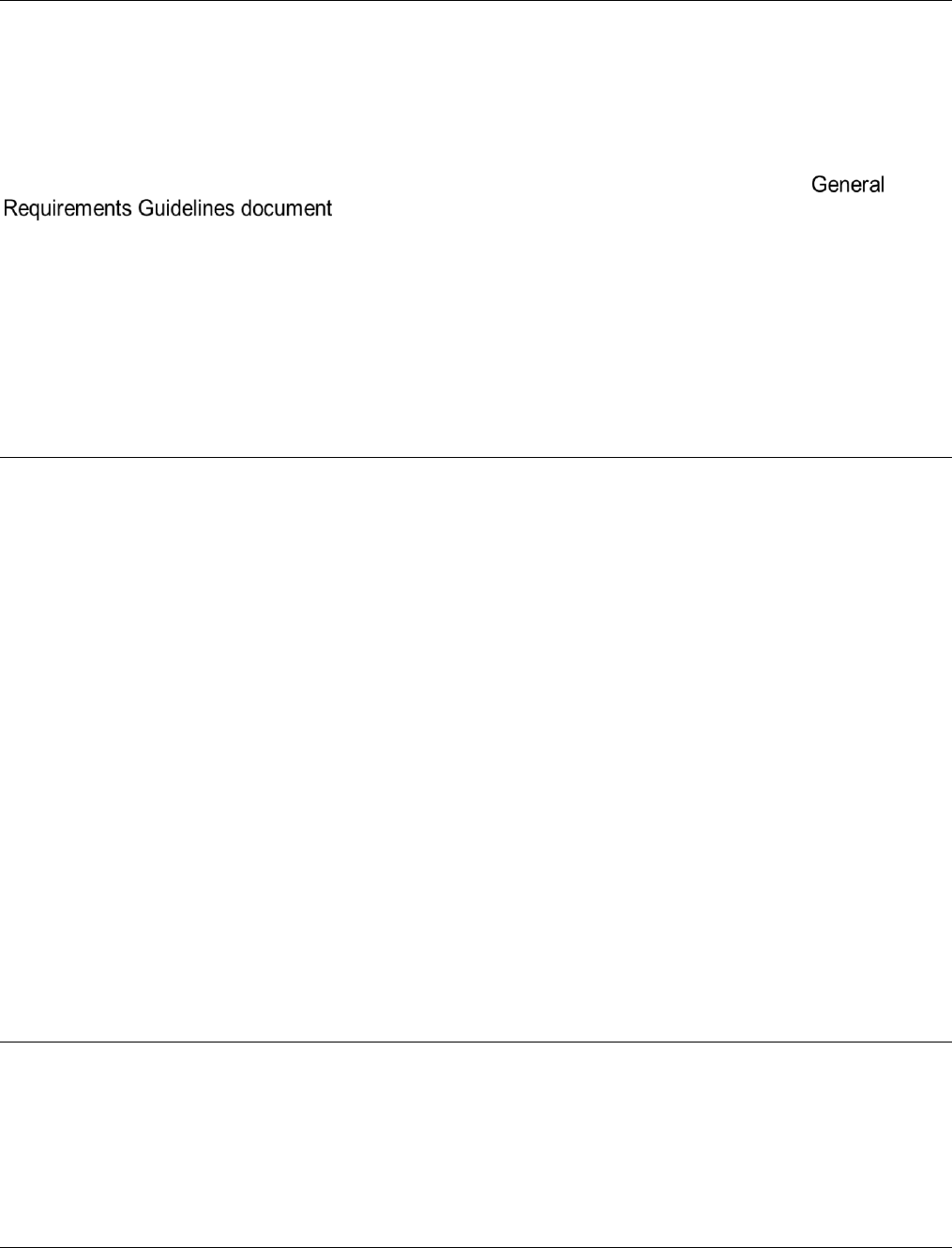
California Department of Technology 4
SIMM Section 170B
Project Requirements Development Instructions August 2016
1. Introduction
These instructions, based on proven industry practices, methods and experience on California
information technology (IT) projects, are designed to assist Agencies/state entities during the
development of project requirements. Though listed as Steps 1-6, projects may follow a different
process and use specific steps, or go through one or more steps several times. In general, most
projects will follow a similar process of requirement development, requirement management, and
requirement refinement.
Where applicable, refer to the Statewide Information Management Manual (SIMM) 170A
for instructions during Project Approval Lifecycle (PAL). The
assumption is made that the progression of requirements work products that a project creates will
follow the PAL in some manner.
Document Format Information:
Guidance information is provided in normal text.
Samples are provided in italicized text.
1.1 Overview
Bidding communities design solutions to specified requirements recorded in IT solicitation packages.
Solicitation requirements often have a substantial associated cost. Due to the associated cost, it is
critical that strong, well-developed requirements provide a clear understanding of the project need and
eliminate ambiguity, thereby reducing costs. As a result, this instruction was created to assist
Agency/state entities in the development and management of project requirements.
This document is divided into three separate sections with step-by-step instructions for IT solicitation
requirements development – from the establishment of project objectives, to their maturity into mid-level
solution requirements, and ultimately, detailed solution requirements.
Initially during PAL Stage 1 Business Analysis, the project identifies business objectives based on
business needs. These objectives are expanded to mid-level solution requirements during Stage 2
Alternatives Analysis and further expanded to detailed solution requirements in Stage 3 Solution
Development. For the purposes of the PAL, the Stage 2 mid-level solution requirements provide high
level solution requirements used to guide in the development of Stage 3 detailed solution requirements,
which include concise specifications of the expected quality of service and functionality. The details are
to be precise, specific, and biddable simple statements of need that, when combined, indicate the
manner in which the mid-level requirement must be achieved. Both the mid-level and detailed solution
requirements are classified into functional, non-functional, and project/transition type requirements;
however, detailed solution requirements can be further categorized in order to effectively manage,
maintain, and track requirement development.
1.2 Background
Few professionals are able to create strong and well-developed requirements. Strong requirements
typically go through a long methodical process with extensive critical stakeholder reviews, edits for
technical correctness, reviews for legal appropriateness, and prioritized based on business need
before becoming well-developed requirements. These instructions are designed to supplement in-
depth learning, formal classroom training, and study of requirements to enhance an Agency/state
entity’s ability to develop strong, well-developed requirements.
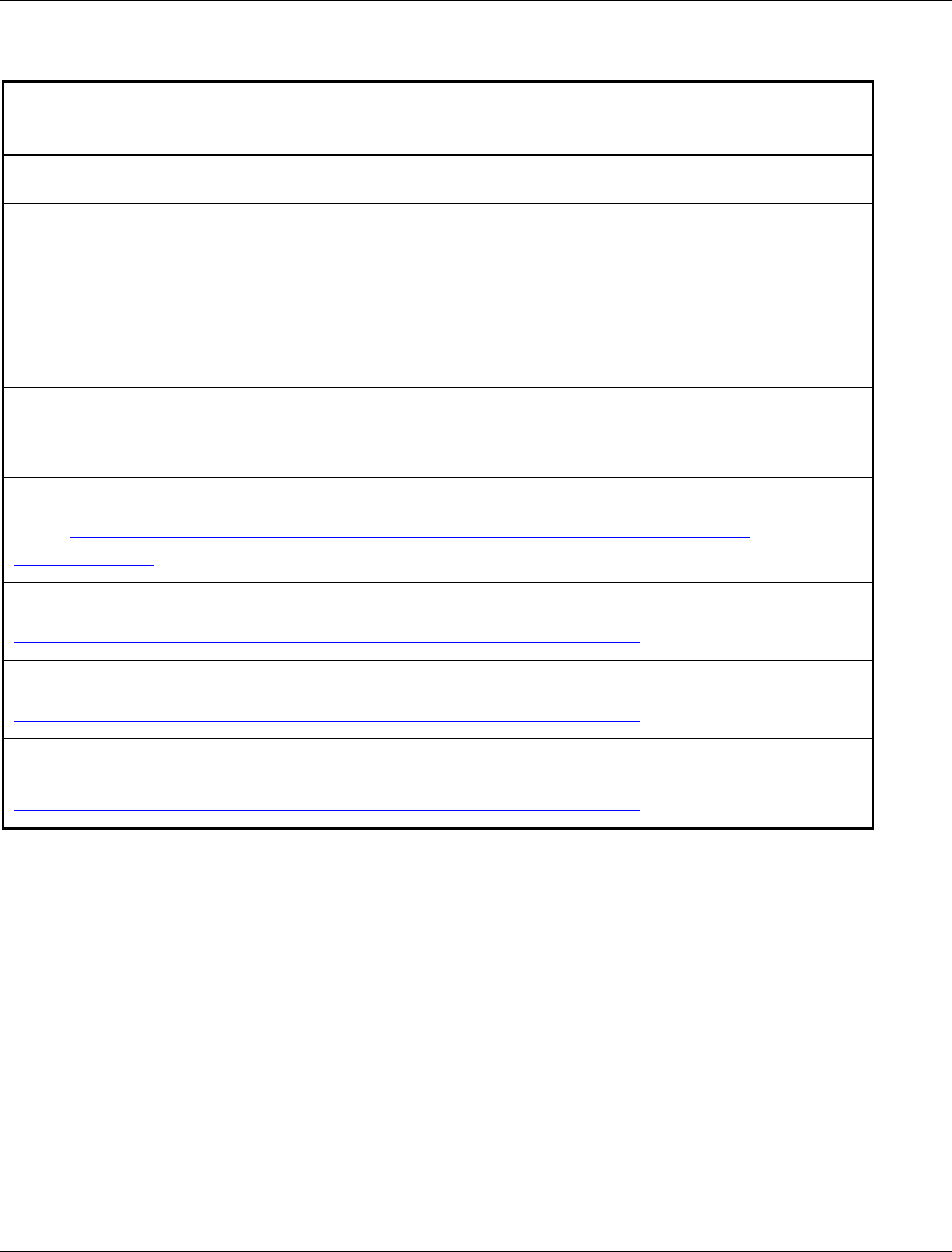
California Department of Technology 5
SIMM Section 170B
Project Requirements Development Instructions August 2016
1.3 References
The following have been created to guide state IT project and procurement staff in one approach to use
in developing strong, well-written requirements:
DOCUMENT REFERENCES
SIMM Section 170A General Requirements Guidelines
SIMM Section 170A Exhibit A Strong Requirement Samples
SIMM Section 170B Exhibit B1-3 Expanded Requirement Samples
SIMM Section 170B Exhibit C Glossary Sample
SIMM Section 170B Exhibit D Requirements Development Workflow
SIMM Section 19 – Stage 1 Business Analysis
http://www.cio.ca.gov/Government/IT_Policy/SIMM_19/SIMM19.html
SIMM Section 19A Stage 1 Section 1.10 Business Problem or Opportunity and Objectives
Table http://www.cio.ca.gov/Government/IT_Policy/pdf/SIMM19/A.1-Preparation-
Instructions.pdf
SIMM Section 19B Stage 2 Section 2.6 Mid-Level Solution Requirements
http://www.cio.ca.gov/Government/IT_Policy/SIMM_19/SIMM19.html
SIMM Section 19B Stage 2 Mid-Level Solution Requirements Template
http://www.cio.ca.gov/Government/IT_Policy/SIMM_19/SIMM19.html
SIMM Section 19C – Stage 3 Solution Development
http://www.cio.ca.gov/Government/IT_Policy/SIMM_19/SIMM19.html
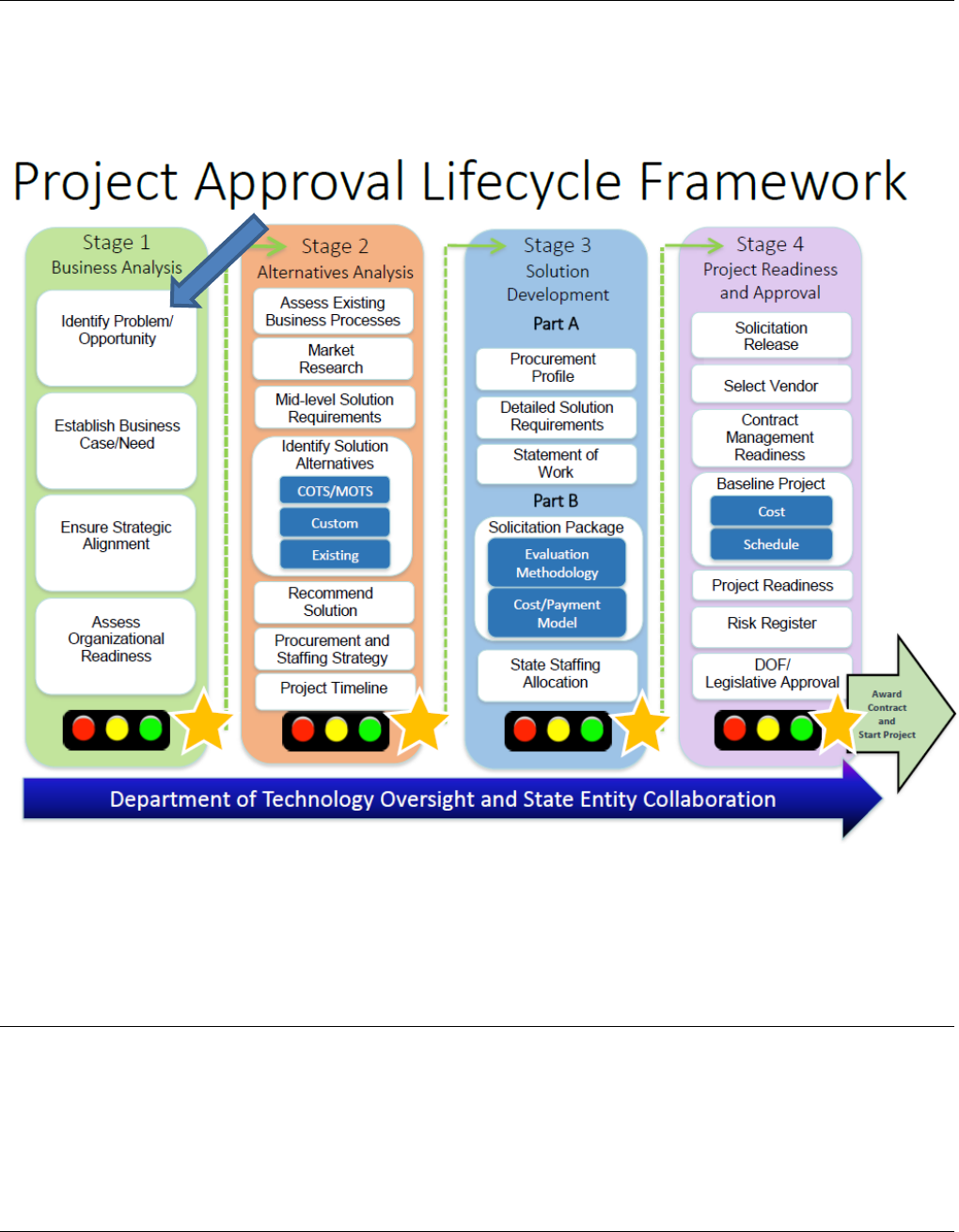
California Department of Technology 6
SIMM Section 170B
Project Requirements Development Instructions August 2016
1.4 Requirements Evolution
In order to create strong solicitation requirements, strong project objectives precede them in PAL Stage
1 Business Analysis.
Figure 1: Project Approval Lifecycle (PAL)
These instructions are applicable when the project team members, stakeholders, and sponsors
understand, agree, and approve the project’s documented business objectives, problems and
opportunities in a PAL Stage 1 Business Analysis. The remainder of this instruction will step through
the requirement maturity development process.
1.5 Project Glossary
Beginning in Stage 1 (prior to requirements development), establish a project glossary to maintain the
terms used during the PAL. Do not assume that it is not necessary to define commonly used terms
(e.g., online form, real-time, user-friendly).
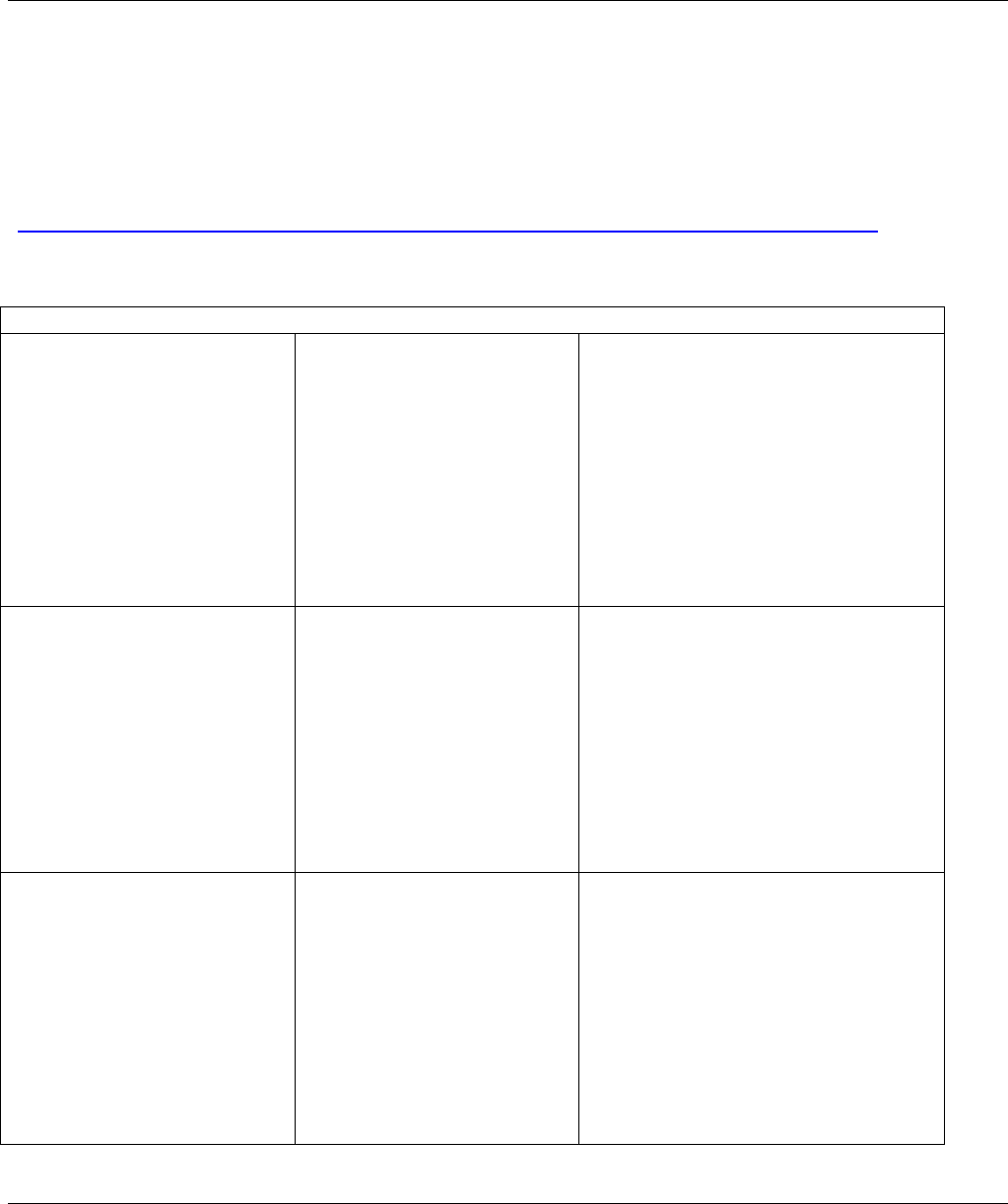
California Department of Technology 7
SIMM Section 170B
Project Requirements Development Instructions August 2016
2. Requirements Development within the Project Approval Life
Cycle
2.1 STEP 1: Project Business Objectives Verification
2.1.1 Step 1 Inputs/Outputs
Step 1 Input(s): Stage 1 Business Objectives
Step 1 Output(s): Verified Stage 1 Business Objectives, Established/Updated Project Glossary
Due to the possible extensive timeframe between the establishment of the business goals and
objectives to the development of the business’s mid-level and detailed solution requirements, it is
recommended that project team members and necessary stakeholders re-familiarize themselves with
the stated objectives. Evaluate that the business goals and objectives are SMART (i.e., “S” Specific,
“M” Measurable, “A” Achievable, ”R” Realistic, and “T” Time Bound)
(http://www.cio.ca.gov/Government/IT_Policy/pdf/SIMM19/A.1-Preparation-Instructions.pdf).
Table 1: SMART Objectives Verification
SMART Objectives Verification
Why is this outcome
important to do?
Who is going to do
what?
When does the project
team want this result
completed?
Does the objective clearly state
what needs to happen?
Will this objective lead to the
desired results?
Is the objective well understood?
How will the project know that
the change has occurred?
Can these measurements be
obtained?
Can it get done in the proposed
timeframe?
Does the project understand the
limitations and constraints?
Does the project have the right
resources?
Have other similar projects
achieved success?
Is this possible?
SPECIFIC: Objectives
must communicate
what needs happen;
the result. They should
be action-oriented and
detailed, well-defined
and focused on what’s
most important.
MEASUREABLE: The
measurement source is
identified and the project
is able to track the
results as progress is
made towards achieving
the objective.
Measurement helps a
project know when the
objective has been
achieved.
ACHIEVABLE:
Maintain balance
between obtainable
objectives while also
focusing on
organization growth or
improved service. If the
objective is too far into
the future, motivation
may dwindle.
What is this objective
going to produce?
How will the project
know or measure when
an objective is
achieved?
Is the project’s
business objective(s)
achievable?
What exactly is the objective
going to do, with or for whom?
Is the objective outcome clear to
anyone who reads it?

California Department of Technology 8
SIMM Section 170B
Project Requirements Development Instructions August 2016
SMART Objectives Verification
Is the project’s business
objective(s) realistic?
Is the project a high priority to
the organization?
Is it possible to achieve this
objective?
Are resources available to
achieve this objective?
Is the project a high priority to
the organization?
Is objective achievable in the
timeframe specified?
2.2 STEP 2: Mid-Level Solution Requirements Development
2.2.1 Step 2 Inputs/Outputs
Step 2 Input(s): Approved Stage 1 Business Objectives, Project Glossary, Requirement
Development Plan (Section 3), Requirements Management Plan (Section 4), SIMM 170A
General Requirements Guidelines
Step 2 Output(s): Completed Mid-Level Solution Requirements Template, Requirements
Traceability Matrix, Requirements Repository, Updated Project Glossary
During the Stage 2 mid-level solution requirements development, determine what business driven
functionally needs to occur in order to fulfil the objective’s goal (from Stage 1 Business Analysis). Focus
to specific details of WHAT needs to occur. The Stage 3 detailed solution requirements will describe
HOW functionality occurs.
This step initiates the requirements development process and introduces the project to requirements
management. During this process:
Identify requirement stakeholders
Document as-is business processes
Elicit stakeholders for information that will become requirements
Analyze, critique, and vet stakeholder requirements
Document requirements within the requirements repository
Initiate requirements traceability
NOTE: Sections 3 and 4 provide an approach to perform stakeholder identification, elicitation,
requirements analysis and approval processes to support these activities.
Track requirements during the development process. The number of mid-level solution
requirements can range from dozens to hundreds depending on the project size and scope.
Establish a requirements repository.
Enforce requirements traceability.
REALISTIC: The project
has the resources to
accomplish the work as
expected. Resources
are the necessary
people, budget, skills,
knowledge, equipment,
and the project’s priority.
Achievable objectives
are not always realistic.
TIME-BOUND:
Objectives should have
achievement deadlines.
Deadlines help to set the
necessary focus and
priority, and prompts
timely action.
Is the project’s business
objective(s) attached to
a certain amount of
time?
The project has the resources
available to achieve this
objective?
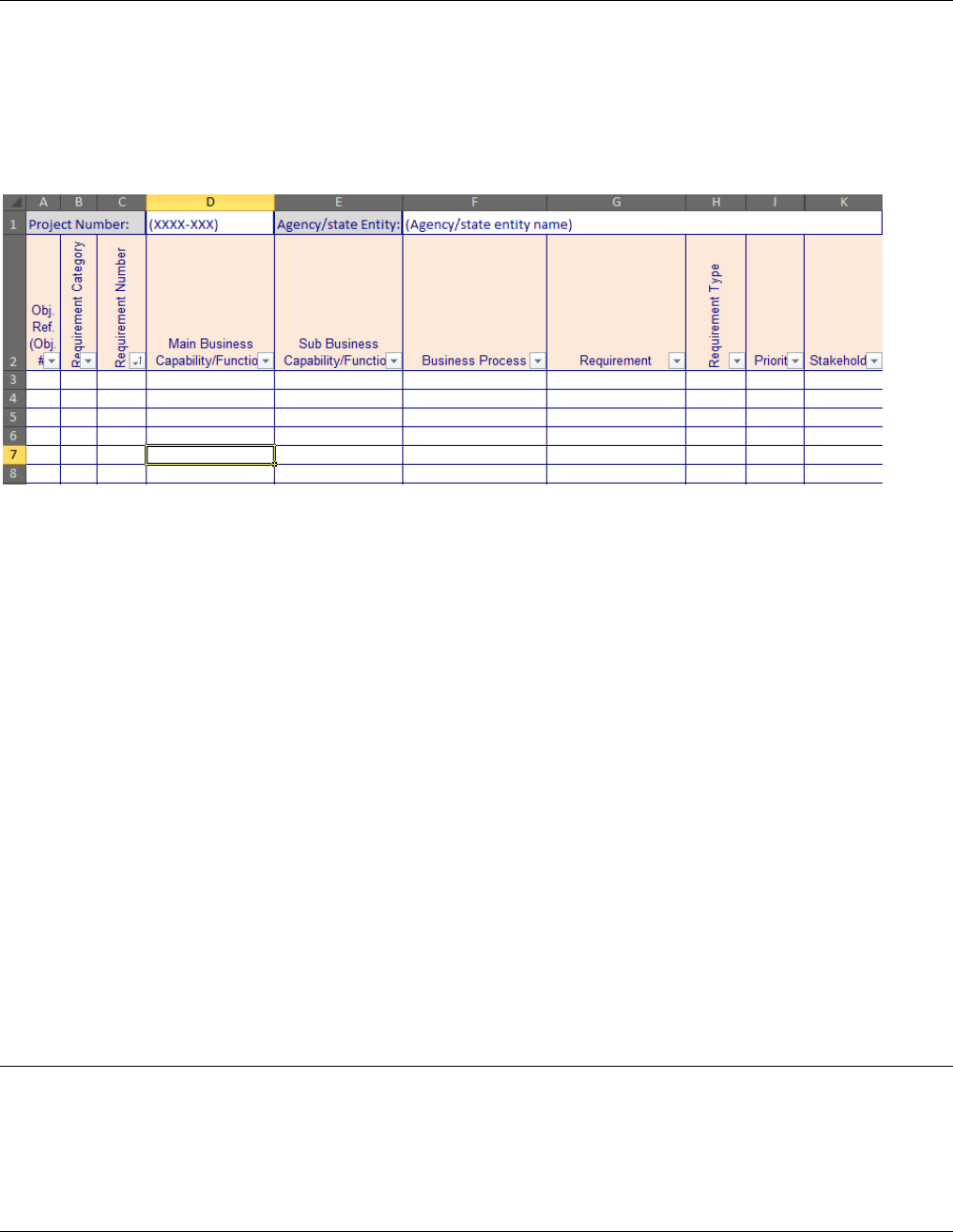
California Department of Technology 9
SIMM Section 170B
Project Requirements Development Instructions August 2016
2.2.2 Mid-Level Solution Requirement Template
Mid-level solution requirements may be captured on the SIMM 19B.3 Mid-Level Solution Requirements
Template. Agencies/state entities may use another tool to capture, track, and maintain mid-level
solution requirements as long as the required fields noted in template are included in their requirements
submission. Instructions to complete the template can be referenced in SIMM 19B Stage 2 Alternatives
Analysis.
Figure 2: Stage 2 Alternatives Analysis Mid-Level Solution Requirements Template
Mid-level solution requirements provide a methodical, organized explanation of what a project is
expected to deliver and should be heavily analyzed, however, it is not necessary to use the same rigor
as for the development of detailed solicitation requirements.
A single standard development process does not exist for mid-level solution requirements. Below are
some of the mid-level solution requirement development processes:
Conduct Joint Application Design (JAD) sessions in order to elicit business needs from
stakeholders
Informally meet with users to conduct line-of-business interviews and/or create business use-
case scenarios to explain current business flow(s)
Observe line-of-business users to document business processes
Procure off-the-shelf IT requirements, then “pick-n-pull” and tailor the requirements to best
represent the business need.
Hire contractors to conduct requirements development work.
One development approach is available for reference in Section 3. Additionally, Agencies/state
entities may refer to A Guide to the Business Analysis Body of Knowledge (BABOK® Guide) for
additional requirement and business need elicitation methodologies and processes.
2.2.3 Mid-Level Solution Requirements Types
Mid-level solution requirements describe the conditions, functionality and capabilities that a solution
must have to satisfy the business needs identified in the objectives; they are sub-classified into
functional, non-functional and project/transition requirements. (Refer to SIMM B.1 Section 2.6 Mid-Level
Solution Requirements).

California Department of Technology 10
SIMM Section 170B
Project Requirements Development Instructions August 2016
Figure 3: Stage 2 Mid-Level Solution Requirements (SIMM Section 19B.1)
Determination if a requirement is functional or non-functional can be challenging depending on the
viewpoint from which the requirement was created. Requirements can exist as functional or non-
functional and can be argued to reside in either column depending on who (business or non-business)
wants to own it. Look at the following example:
“The solution shall support a four-digit year in all date fields and functions.”
This requirement may be categorized as functional because it describes a requirement behavior of the
solution. This requirement may also be categorized as non-functional because it describes a solution
design constraint.
Stage 1 –
Business Analysis
Business Requirements -
Goals, objectives and
outcomes identified.
Stakeholder Needs
Captured
Stage 2 –
Alternatives Analysis
Process Flows - The
graphic representation of
the business processes.
Mid-Level Solution
Requirements -
Characteristics of a solution
scope and quality of
service. They describe the
conditions, functionality and
capabilities that a solution
must have to satisfy the
business needs identified in
the objectives; they are
sub-classified into
functional, non-functional
and project/transition
requirements.
Functional Requirements
- Feature level information
to validate the size of the
system. Generally they are
“what” the business has
identified they want.
Non-Functional
Requirements -
Information to validate
alternatives. Generally the y
are what/how non-business
(i.e., technologists) want or
need to satisfy what th e
business has identified the y
want.
Project/Transitio n
Requirements -
Information to validate the
feasibility of cost and
schedule. Generally the y
are temporary in nature and
exist while the Project i s
progressing through projec t
phases prior to project close
and the solution becomes
the new “as-is.”
Stage 3 –
Solution Development
Detailed Solutio n
Requirements - The y
represent large groupings of
concise specifications tha t
when combined deliver an
expected quality of servic e
and functionality of a
solution. They are sub-
classified into functional,
non-functional, and
project/transition
requirements.
Detailed Functional
Requirements -
Specifications to ensure th e
system meets stakeholde r
needs.
Detailed Non-Functional
Requirements -
Specifications to ensure th e
system operates as
required; identifies qualitie s
of the system and
constraints on the system.
Detailed
Project/Transitio n
Requirements -
Specifications to ensure th e
system is built on time and
budget and meets quality
levels.
Detailed
Mandatory/Optional
Requirements -
Specifications on optional
requirements (e.g. ,
maintenance and
operations after first year of
operations) that will b e
implemented at the option
of the state.
Administrative
Requirements -
Requirements that are
defined by the Department
of Technology, STPD and
included under a separate
section of a solicitation
Stage 4 –
Project Readiness and
Approval
Baseline Functional
Requirements -
Information to test and
subsequently maintain
the desired functionalit y
in the system.
Baseline Non-
Functional
Requirements -
Information to test and
subsequently maintain
the quality and
operational aspects of
the system, within th e
defined constraints.
Baseline
Project/Transitio n
Requirements –
Information to test and
subsequently maintain
the quality, budget and
time constraints.
Baseline
Mandatory/Optional
Requirements –
Information t o
subsequently maintain
and validate the need t o
implement optional
requirements (e.g. ,
maintenance and
operations after first year
of operations).

California Department of Technology 11
SIMM Section 170B
Project Requirements Development Instructions August 2016
Answer these questions, “Who wants the requirement delivered?” and “Does this requirement
indicate how delivery will be achieved?”
Apply the following logic to determine whether requirements are functional, non-functional, or
project/transition requirements:
Functional requirements generally are “what” the business has identified they want.
Non-functional requirements generally are what/how non-business (i.e., technologists) want
or need to satisfy what the business has identified they want.
Project/transition requirements generally are temporary in nature and exist while the project
is progressing through project phases prior to project close and the solution becomes the
new “as-is” (e.g., contractor requirements, solution transition requirements, training, and
project specific requirements).
After applying the above logic, “The solution shall support a four-digit year in all date fields and
functions,” is considered a functional requirement because the business required that the date be
rendered in a specific way.
It is common to complete the PAL Stage 2 with more functional than non-functional and/or
project/transition requirements since during this stage the business is providing functionality needs as
opposed to how the functionality must be delivered.
Reference: Section 4 Requirements Development Guideline in the SIMM 170A General Requirements
Guideline and SIMM 170A Exhibit A: Strong Requirement Samples should be referenced to provide
further detail on writing strong mid-level solution requirements.
In the following example(s), the mid-level solution requirements express what is required to meet the
business objective without specifying detailed requirement implementation details.
Table 2: Mid-Level Solution Requirements
Business Objective
Mid- Level Solution Requirement
1. “Decrease manual processing of
license applications by 70%
within the first year of online
processing availability to
Californians. “
1.1 Functional: License applications and
transaction processing will be available online.
1.2 Non-functional: Solution shall implement a
web application form
1.3 Non-functional: Solution will process faxed or
scanned license application submissions.
1.4 Functional: Solution design will duplicate
license application processing workflow.
(Refer to Exhibit ABC: XYZ Business Process.)
1.5 Functional: Transaction status notifications
will be provided to users.
1.6 Functional: Transactions will be stored and
retained online, and searchable.
1.7
Non-functional: Solution shall implement a
web application form

California Department of Technology 12
SIMM Section 170B
Project Requirements Development Instructions August 2016
Business Objective
Mid- Level Solution Requirement
2. “Process 25% more license
applications annually that will
cumulatively increase revenues
by an estimated $260,000 within
six (6) years of online availability
to Californians.”
2.1 Non-Functional: Solution will scale to accept
and process concurrent license transactions
2.2
Functional: Solution will generate ad-hoc
financial and license reports.
2.3
Functional: Solution will provide point-of-sale
services to users.
2.4
Functional: Solution will provide dynamic user
profiles.
2.5
Functional: Solution will provide self-service
license purchases to users.
2.6
Project/Transition: Solution will provide dual-
processing until two (2) years after year end
close.
2.2.4 Mid-Level Solution Requirements Management
The project should have a set of categorized mid-level solution requirements supported by
management, executives and sponsors that do not appear to be outside of scope or negatively impact
cost or schedule. During the vetting process, the requirements are further scrutinized for aspects such
as:
Does the requirement follow or conflict with state, federal or local laws?
Does it define the “How” of what is being procured or is the focus on the “What” (as it should
be)?
Does the requirement provide the outcome as it was intended by the stakeholder?”
Section 4 Requirements Management is designed to efficiently control analysis that results in the need
to modify mid-level solution requirements. Strategies to conduct requirement reviews include:
Hire consultants to review and report on the strength of the requirements
Conduct market research to determine whether or not the requirements appear to ask
for realistic, affordable solutions.
Ask a partner project or Agency/state entity to review the requirement.
Regardless of how this is achieved, the goal is to present the requirements set to as many willing
reviewers as possible, as efficiently as possible.
Reviewers should be kept informed of:
How the review process functions
How the review is progressing
Failure to engage in this type of communication may result in future unwillingness be a reviewer.
Changes to baseline mid-level solution requirements may occur. Be sure that changes to these
requirements follow the project’s established requirements change process, are documented/traced
within the requirements repository, approved by appropriate stakeholders, and communicated to all
project team personnel.

California Department of Technology 13
SIMM Section 170B
Project Requirements Development Instructions August 2016
Capture and maintain traceability to project objectives on a current basis. Ensure that each requirement
stakeholder (requirement owner) is identified; current, and documented and aware of the requirement
change management process should modifications/requests for changes arise that impact their
requirement.
Mid-level solutions requirements should be approved by project stakeholders, team members, relevant
business partners and project sponsor representatives, at a minimum. Once vetting and decision
making processes are completed, they will represent the baseline requirements. These baseline
requirements will be used to expand into detailed solution requirements during the Stage 3; explained
in Step 3 of this instruction.
2.3 STEP 3: Detailed Solution Requirements Development
2.3.1 Step 3 Inputs/Outputs
Step 3 Input(s): Requirements Development Plan, Requirements Management Plan, Approved
Mid-Level Solution Requirements
Step 3 Output(s): Approved Detailed Solution Requirements Template, Updated Requirements
Repository, Updated Glossary, Requirements Traceability Matrix
Generally, detailed solution requirements represent large groupings of concise specifications that when
combined deliver an expected quality of service and functionality of a solution. This step is where the
project will spend many hours developing detailed solution requirements. Once the mid-level solution
requirements have been approved and properly documented, the detailed requirements can be
developed.
Even though stakeholders and business partners were elicited for input, the resulting requirements may
seem disjointed. There is no reason for concern, as that is normal. Until the requirements have been
honed to be concise strong requirements, they will be that way.
Mid-level and detailed solution requirements exhibit a parent-child (one-to-many) relationship. It is
common that mid-level (parent) requirements will expand to have many hundreds of detailed solution
requirements (children) depending on the project scope.
Reference: Examples of this parent-child relationship can be illustrated in SIMM 170B Exhibit
B1-3 Expanded Requirement Samples.
2.3.2 Detailed Solution Requirements Template
Detailed solution requirements may be captured on the SIMM 19C.5 Detailed Solution Requirements
Template. Agencies/state entities may use another tool to capture detailed solution requirements as
long the required fields are included in their requirements documentation submission. Instructions to
complete the template can be referenced in SIMM 19C.1 Stage 3 Solution Development Preparation
Instructions.

California Department of Technology 14
SIMM Section 170B
Project Requirements Development Instructions August 2016
Figure 4: Stage 3 Detailed Solution Requirements Template
2.3.3 Requirement Specifications
Detailed solution requirements will again be represented by the same functional, non-functional,
project/transition type; as in the mid-level solution requirements. The expansion of the mid-level to the
detailed requirement is matured in the “details.” The details are precise and specific; they are simple
statements of need that combined with a group of other simple statements explain the manner in which
a mid-level solution requirement must be achieved. These simple statements must each possess an
attribute, criteria, a requirement, and a test. This is where the accuracy of the Requirements
Traceability Matrix becomes critical. Refer to the SIMM 17 California Project Management Framework
(CA-PMF) for the Requirements Traceability Matrix Template.
Detailed requirements represent performance specifications for a solution. A specification is more
formally defined as, "A statement of required results with criteria for verifying compliance." Performance
specification necessitates clear, definitive communication of required results, but should not
unnecessarily limit the products, methods, or means of achieving those results. There are four essential
elements of these specifications:
Attributes – The means by which performance characteristics are identified. Define the
attributes that will be set at this step. They can be used to support other activities, such as
testing for high priority or criticality requirements, or for reporting. Examples: Functional,
Performance, Usability/Quality-in-Use, Interface, Design Constraint, Process, Non-Functional,
Quality.
Requirements – “1. a condition or capability needed by a user to solve a problem or achieve an
objective. 2. a condition or capability that must be met or possessed by a system, system
component, product, or service to satisfy an agreement, standard, specification, or other
formally imposed documents 3. a documented representation of a condition or capability as in
(1) or (2) 4. a condition or capability that must be met or possessed by a system, product,
service, result, or component to satisfy a contract, standard, specification, or other formally
imposed document. (IEEE 24765:2010 ). These are statements of desired results, in
qualitative or quantitative terms. Note that more than one requirement may be defined for a
single attribute.
Criteria – Definitive statements of performance for a particular requirement, stated in
quantitative or qualitative terms. Criteria must be either measurable or observable. Several
criteria may be needed to completely and accurately define a requirement.

California Department of Technology 15
SIMM Section 170B
Project Requirements Development Instructions August 2016
Tests – Checks for conformance with performance criteria and a measure of actual or predicted
performance level. A test will be associated with each criterion and may be based on a
recognized test method, calculation or engineering analysis, observation, or professional
judgment. Test results may be evaluated by conducting the specified test, or simply by
submitting certified results of previous testing.
In reference to the functional mid-level solution requirement from Section 2.2.2:
“The solution shall support a four-digit year in all date fields and functions.”
A non-functional detailed solution requirement to support the delivery of the functional mid-level solution
requirement, as the non-business (technologist) requires that the official system of record for the date
be provided by the Network Time Server, could be:
“The solution shall use the time and date provided by the State Network Time Server.”
Reference: Refer to Section 4 Requirements Development Guideline in the SIMM 170A General
Requirements Guidelines for further detail on writing strong detailed solution requirements.
The following table provides detailed solution requirements expanded from the mid-level solution
requirements developed in Step 2. They are simple concise “child” statements that when combined,
indicate how the “parent” mid-level requirement (the “what”) will be satisfied. Each of the detailed
solution requirements has notable requirement specifications (attributes, criteria, requirement, and test)
characteristics.

California Department of Technology 16
SIMM Section 170B
Project Requirements Development Instructions August 2016
Table 3: Detailed Solution Requirements Examples
OBJECTIVE
MID-LEVEL
SOLUTION
REQUIREMENT
DETAILED SOLUTION
REQUIREMENT
1.
“Decrease
manual
processing of
license
applications by
70% within the
first year of
online
processing
availability to
Californians. “
1.1
License applications and
transaction processing will
be available online.
1.2
Solution design will
duplicate business
processes to transfer
work between state
staff.
1.3
Transaction status
notifications will be
provided to users.
1.1.1. Non-functional: Solution to be
accessible via a Browser.
1.1.2 Functional: Solution to receive online
license request submissions, pay for
licenses, provide receipt, and
transaction notification.
1.1.3 Functional: Design solutions to allow
users to reset forgotten passwords,
update profile information, and apply
for multiple licenses.
1.1.4 Functional: Solution to allow users to
print license placards upon
confirmation of the transaction.
1.1.5 Functional: Solution to process
submitted online transactions.
1.1.6 Functional: Solution to provide
online printable receipts, and email
notifications for transactions, (See
Exhibit X, Example Receipts,
Transactions and Notifications for
criteria and content).
1.1.7 Functional: Solution to allow users to
apply for multiple licenses during a
single online license request
submission request session.
1.2.1 Non-functional: Application workflow
will be configurable to changes in
business processes.
1.2.2 Non-functional: Total transaction
duration from user submission to
state staff completion will be logged,
retained, and searchable.
1.2.3 Non-functional: User roles will be
configurable.
1.3.1 Non-functional: Design solution to
notify users via email or text
message of changes in transaction
status.
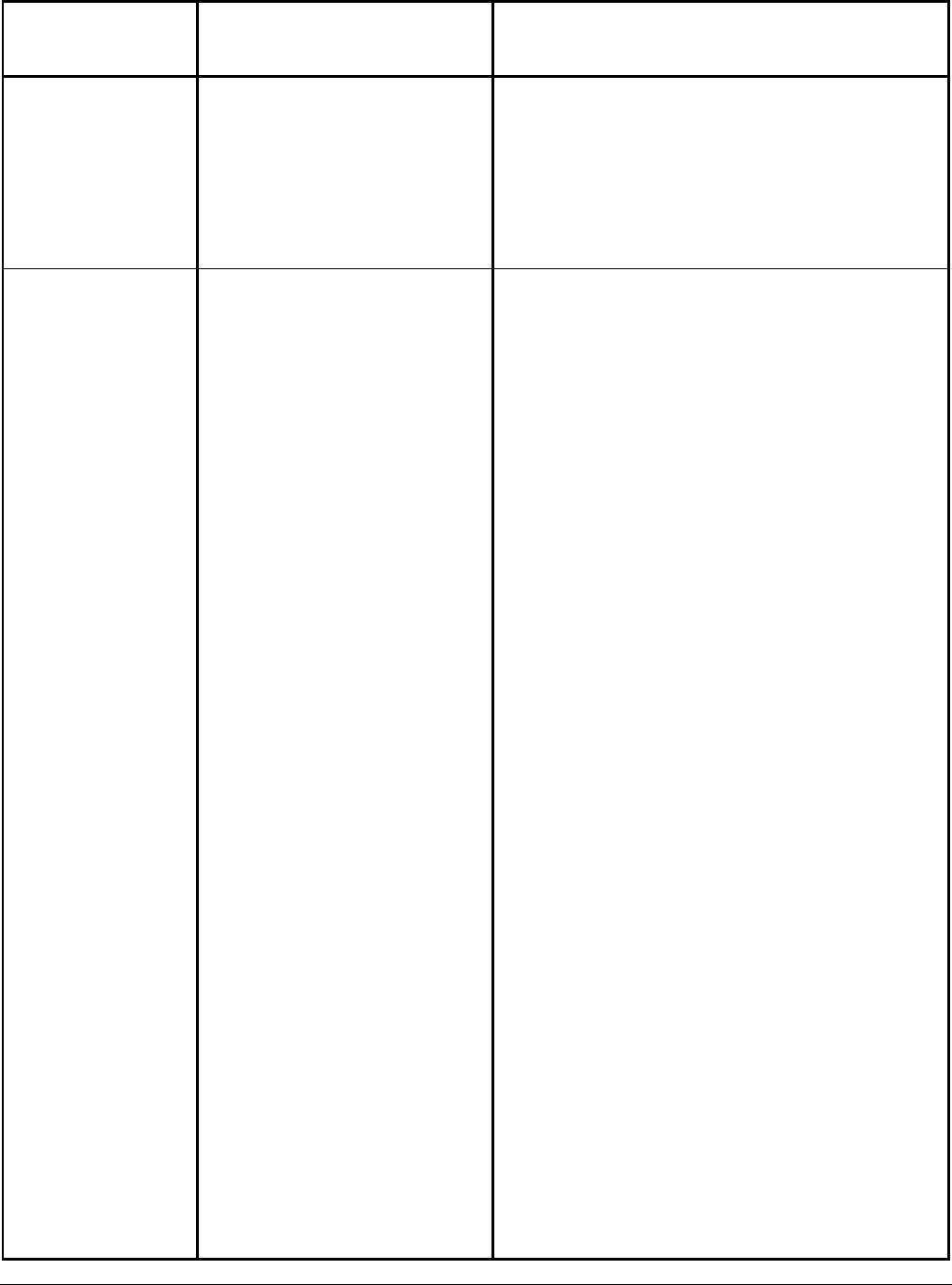
California Department of Technology 17
SIMM Section 170B
Project Requirements Development Instructions August 2016
OBJECTIVE
MID-LEVEL
SOLUTION
REQUIREMENT
DETAILED SOLUTION
REQUIREMENT
1.3.2
Non-functional: Flagged transactions
will provide status notification to
users once weekly until the
transaction is no longer flagged.
1.3.3
Non-functional: Design the solution
to generate automatic notification of
unsuccessful processing to users.
2.
“Process 25%
more license
applications
annually that
will cumulatively
increase
revenues by an
estimated
$260,000 within
six (6) years of
online
availability to
Californians.”
2.1 Solution will scale to
accept and process
concurrent license
transactions.
2.2 Solution will generate
ad-hoc financial and
license reports.
2.3 Solution will provide
point-of-sale services
to users.
2.1.1 Non-functional: A minimum of 100
concurrent user transactions must
be available during peak application
season each year
2.1.2 Non-functional: Design solution to
implement transaction throttling.
2.1.3 Non-functional: Design the solution
to scale system resources to process
100 concurrent user transactions
within five (5) minutes.
2.2.1 Functional: Design solution to
produce sales reports that span
configurable durations (see Exhibit X
for Sales Reporting).
2.2.2 Non-functional: Reports will be stored
and retrievable in the database.
2.2.3 Functional: Design solution to permit
state staff to modify information on
printed reports.
2.3.1 Non-functional: Solution will adhere
to Payment Card Industry 2.0
compliance standards.
2.3.2 Functional: Design solution to
process Visa, MasterCard and
Discover payment card information.
2.3.3 Functional: Design solution to
transfer total payment amount of
transactions to the Financial
Balances System.
2.3.4 Non-functional: Users will receive
confirmation of payment during the
transaction session as payment is
confirmed from the payment card
vendor.

California Department of Technology 18
SIMM Section 170B
Project Requirements Development Instructions August 2016
2.3.4 Categorizing Requirements
In order to more easily manage detailed solution requirements, classify them into a variety of project
applicable categories. Categorization can vary depending on the project need and focus.
Functional, non-functional, and project/transition requirements are not logically categorized enough to
be practically managed or applied. In order to better communicate, trace and search requirements with
greater success, organizing requirement groups by category can be quite beneficial.
Classifying requirements will provide structure to the mid-level and detailed solution requirements.
Structured logical groups of requirements are more easily managed and make verifying of requirements
delivery easier and, once delivered, produces a valuable performance deliverable.
Figure 5 is a sample classification structure for IT system requirement elements and related work.
Elements, as defined here, are major components common to most IT systems. Elements usually
perform a given function, regardless of design specifications, implementation method, product or
materials used. This instruction suggests a maximum three level definition. Starting from Level 1, the
largest element grouping, it identifies Major Group Elements such as the Business, Information,
Application, and Technology. Level 2 subdivides Level 1 elements into Group Elements. The
Technology, for example, includes the Node and Communication Services. Level 3 breaks Group
Elements further into Individual Elements. A Node, for example, includes physical hardware with
resources with processing capability.
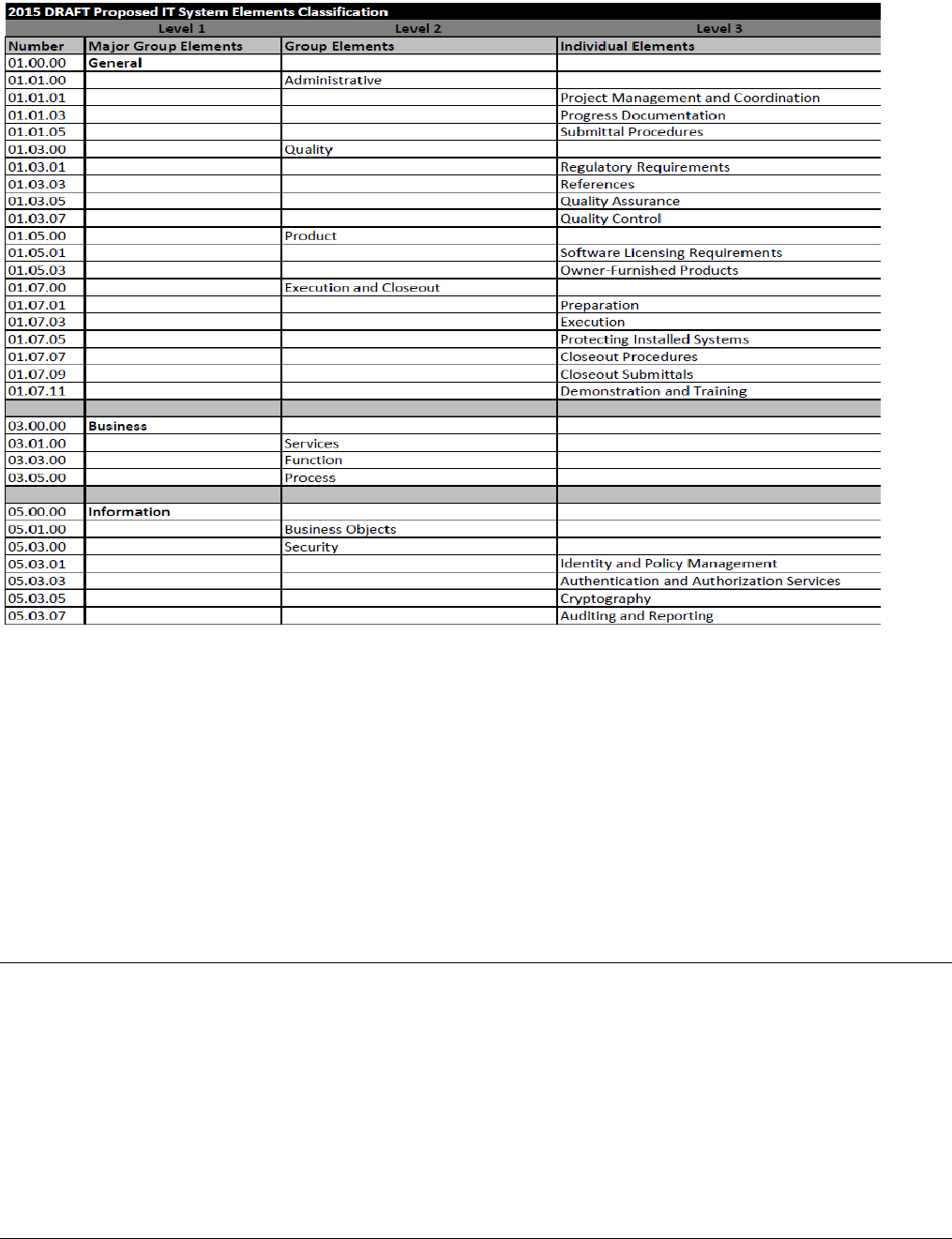
California Department of Technology 19
SIMM Section 170B
Project Requirements Development Instructions August 2016
Figure 5: Category Group Levels
Performing economic analysis based on an elemental framework instead of on a product-based
classification provides an opportunity to reduce time and costs for evaluating alternatives at early
design stages. This encourages more economic analyses and more economically efficient choices
among systems and system elements.
Ultimately, the existing stakeholder defined requirement “category” and “type” allow introduction of
standardized categories to:
1. Minimize disruption to existing methods; and,
2. Maximize long-term value to the State, citizens and project quality improvements.
2.3.5 Classification Framework
The requirements classification framework, the selection of items to include, and the decisions of which
parts of the classification to include are based on the following criteria:
Selected items have a significant influence on project cost
Selected items have high frequency of occurrence
Selected items are distinctive
Hierarchical structure allows aggregation and summarization at different levels
Suitable for a range of applications, including cost control and preliminary project descriptions
Accommodate unlisted items based on the judgment of IT professionals

California Department of Technology 20
SIMM Section 170B
Project Requirements Development Instructions August 2016
Professional judgment is used to place elements where IT professionals in current practice
would normally look for such items in a classification structure.
2.3.6 Detailed Solution Requirements Management
Detailed solution requirements analysis and acceptance processes follow a similar approach as in Step
2 for mid-level solution requirements. However, some differences include:
New stakeholder participation and increased elicitation meetings
A much lengthier analysis and acceptance process
Significantly more effort spent on requirements specifications and traceability
Potential coordination of the requirements development results to other project deliverables
(e.g., Work Breakdown Structure (WBS), Statement of Work (SOW), Project Plans).
The result of this work will be included in the Project’s IFB/RFP, which will be included in the complete
solicitation package released for vendor bid during the PAL Stage 4 Project Readiness and Approval.
<This concludes the step-by-step requirements development instructions.>

California Department of Technology 21
SIMM Section 170B
Project Requirements Development Instructions August 2016
3. Requirements Development Planning
3.1 Roles and Responsibilities
Identify the individuals and groups and describe their specific roles and responsibilities for requirements
development. This is not meant to be a job description of what the individual or group does on the
project but rather a summary of the roles and responsibilities with respect to requirements
Development.
The following is a listing of the most commonly used project individuals/groups that should be
considered, though all may not be needed and others may need to be added based on the specific
project. Projects must clearly identify the roles and responsibilities associated with each. Do not be
generic and identify responsibilities such as “among the reviewers of …” as this does not convey any
ownership responsibility. If there are groups, such as an Executive Steering Committee or reviewer
groups, then identify the groups and cite where the members of the groups are defined (e.g., the
Project Charter, Deliverables Management Plan).
Do not duplicate roles and responsibilities that are part of and defined within another Project
Management Plan. For example, the approver of a Change Request should be defined in the Change
Management Plan and not repeated here. As the role and responsibility changes in the project’s
lifecycle, it will be difficult to keep multiple plans consistent.
Table 4: Roles and Responsibilities of Requirements Development
TITLE
ROLE
RESPONSIBILITY
Project Executive
Steering
Committee
The Project Executive Steering
Committee’s role is to provide
the final approval of the project
requirements.
Their responsibility is to understand the
approach used to elicit the requirements from
all of the stakeholders as well as the
approach used to develop and finalize the
requirements. Then, when presented with the
requirements, they will review a
representative sample of the requirements to
provide the final level of assurance that the
requirements will communicate the
stakeholders’ needs to any potential vendor.
Executive Project
Sponsor
The Executive Project Sponsor’s
role is to ensure that
requirements’ planning is
executed in a timely and efficient
manner and that the objectives
are achieved.
The Executive Project Sponsor will provide
the necessary support to the Project Manager
to ensure that resources are available to
support the execution of requirement planning
and to provide the advocacy to all of the
internal and external units and organizations
that are required to participate in the
requirements development effort.

California Department of Technology 22
SIMM Section 170B
Project Requirements Development Instructions August 2016
TITLE
ROLE
RESPONSIBILITY
Project Business
Sponsor
The Project Business Sponsor’s
role is to provide the overall
business leadership to ensure
the requirements meet the
needs of users.
If the requirements are deficient,
they will identify issues and
problems that need to be
corrected. Once acceptable, the
Executive Steering Committee
will be responsible for approving
the project requirements, which
will then become baselined and
fall under formal Requirements
Management control.
The Project Business Sponsor is responsible
for ensuring the requirements plan identifies
an approach that addresses all of the
organizational business users, their needs,
and the organization’s business support
needs (e.g., Legal, IT Operations, Public
Relations). The Business Sponsor also
provides advocacy to the business and
supports components of the organization to
ensure that the documented requirements will
meet the overall organization needs.
Ultimately, the Sponsors (Business and
Executive) are responsible for approving the
requirements plan and ensuring that the
activities and tasks are executed by the
Project Manager.
Project Director
The Project Director’s role is to
provide support for the Project
Manager by aiding in the
removal of obstacles and
resolving issues or problems
during the development of the
project requirements that are
beyond the control of the Project
Manager.
The Project Director is responsible for
tracking the progress of the requirements
development effort, identifying significant
deviations, and assisting the Project Manager
in resolving obstacles, issues, and problems
in order to keep the effort on schedule without
compromising the quality (completeness,
correctness, readability, etc.) of the resulting
requirements.
Project Manager
The Project Manager’s role is to
plan, schedule, resource,
monitor, and track the progress
of the requirements
development effort.
The Project Manager is responsible for
working with the Requirements Development
Lead to review the requirements development
approach, verify that all stakeholders are
accounted for and the planned elicitation
approach appears sound for each, and
ensure that the tools necessary to develop,
document, and maintain the requirements
throughout the process are available. The
Project Manager will schedule the activities,
tasks, and resources necessary to execute
the effort and monitor and track the execution.
If obstacles, issues, or problems arise, the
Project Manager will either resolve them or
escalate them to the Project Director or
Sponsors for resolution.

California Department of Technology 23
SIMM Section 170B
Project Requirements Development Instructions August 2016
TITLE
ROLE
RESPONSIBILITY
Requirements
Development
Lead
The Requirements Development
Lead’s role is to lead or perform
the activities and tasks defined
within the requirements plan.
The Requirements Development Lead is
responsible for executing all of the activities
and tasks within the requirements plan and
comply with the planned process. The Lead
will work with the Project Manager to define
and identify the resources needed to
accomplish each activity and task, verify the
tools are available, and assist in scheduling
the execution of the effort.
3.2 Identify Project Stakeholders
It is important to identify, verify, and validate the individual stakeholders and stakeholder
groups/classes that have a legitimate interest in the system throughout its lifecycle for requirement
elicitation. When starting a project, key stakeholders will serve to verify that all requirements are
identified. Therefore, the stakeholders list should be complete and ensure all necessary stakeholders
are included, and exclude unnecessary ones. Ensure to identify stakeholders for the development
effort and also operations and maintenance and other post-deployment users. Stakeholders will be
elicited for requirements for their area of interest. Do not identify specific products (e.g., System
Administration Manual for the IT Unit) but focus on the types of products and services. A product-
based work breakdown structure (WBS) is an excellent starting point to identify stakeholders. From a
WBS perspective, this would be a level-2 or level-3 view of the products and/or services.
The following table serves as an example of key stakeholders and stakeholder groups/classes for the
project and their interest in the project execution and/or the artifacts produced.
Table 5: Example Stakeholder Groups
Stakeholder
Interest
XYZ Unit
IT Support Unit
Enterprise
Architect (EA)
The EA has an interest in ensuring the new system will meet the performance and
other operational needs of the organization.
As a user of the system, they have an interest in ensuring that the system performs
the XYZ functionality necessary for the unit to perform their business function and
that reports can be generated.
Chief Deputy
Director
As an Executive Sponsor, he/she has an interest in ensuring the project cost,
schedule, quality, risks and issues are carefully monitored, managed, and provides
direction to the project. The Executive Sponsor communicates the project status
to other executives and intervenes and resolves escalated issues.
The IT Support Unit has an interest in ensuring the system can be supportable by
the organization and that all artifacts delivered will be usable and accurately reflect
the procedures necessary to be supported by the units’ resources.

California Department of Technology 24
SIMM Section 170B
Project Requirements Development Instructions August 2016
Stakeholder
Interest
Training Office
Department of
Technology
3.3 Eliciting Stakeholder Requirements
For each stakeholder and stakeholder group/class identified in Section 2.1, an approach needs to be
established to elicit their requirements. The elicitation process may be iterative and/or recursive and
repeated as necessary to ensure all of the requirements have been captured. Note that not all
techniques work well with all stakeholders; the project must understand the stakeholders and
stakeholders classes/groups and identify an approach suitable for the specific stakeholder or
class/group. As an example, a top-down business process model to detail user interactions, data, and
rules might work well with specific business users but this same approach would not work well for an
Executive Sponsor or the IT organization that may be maintaining the solution.
For the specific project, clearly identify the technique(s) that will be used for each stakeholder or
stakeholder group/class and plan for iteration and refinement of the technique as more is known about
the needs. While elaborate models are discussed in literature and standards, understand your
stakeholders and determine what will work best for them.
As each identified stakeholder and stakeholder group/class is elicited, the requirements and supporting
artifacts shall be documented in various forms and formats. In the early iterations, it is anticipated that
the documentation created will be primarily graphical in nature, such as flow charts, pictures from white
boards, etc. These types of documents will be captured in the form that they were developed -- Visio,
PowerPoint, photo (jpeg), etc. However, as the requirements are refined, they should be documented
in a MS Word format or other standardized format to allow for further analysis. When documenting
requirements at all levels, the requirement context will always be kept with the set of requirements
being collected.
The project needs to define the format and structure of the final elicited requirements documents, which
are the documents that will be provided for the requirements analysis activity. This is important for a
number of reasons: 1) it establishes a common and consistent expectation of the types of data that
must be collected for each context area; 2) it supports the analysis activity and tasks by providing a
consistent input into the categorization and filtering of requirements; 3) it reduces the amount of re-
writing that the analysis team will need to do to ensure context and requirements sets are defined; and,
4) it simplifies the identification of missing or incomplete requirement sets during both elicitation and
analysis. While the Use Case approach to documenting the final elicited requirements is identified
here, any artifact that keeps the requirements context with the set and types of requirements elicited is
sufficient.
The Training Office has an interest in ensuring that the system documentation and
training material is developed, with appropriate tools available as necessary to
train all of the impacted stakeholders.
The PM has an interest in managing the execution of the project and ensuring that
there are sufficient artifacts created and delivered that will allow the necessary
tracking, managing, and reporting for the project.
Department of Technology has an interest in the project to provide oversight and
enforcement of the state’s IT strategic plans, policies, and procedures, and assists
in planning and implementing successful IT projects.
Project
Manager (PM)

California Department of Technology 25
SIMM Section 170B
Project Requirements Development Instructions August 2016
All requirement artifacts collected shall be stored in the requirements repository. The artifacts captured
will consist of all tools, techniques, diagrams, flow charts, photos, documents, files, etc., that were used
in the elicitation process. While some of these artifacts will be used as reference later during the
analysis activity, others will be formalized to define or support the requirements and will be incorporated
into the final requirements document (e.g., the baseline requirements document).
During the elicitation effort, the collected requirements will not be reviewed or analyzed in any way
other than to ensure that the captured requirements are clear, complete, and understandable. Review
and analysis occurs later, as described in Section 3.8.
The following is an example of which elicitation approach was identified for each stakeholder:
Table 6: Example Elicitation Approach
Stakeholder
Elicitation Approach and Iteration/Recursion
XYZ Unit
The initial approach that will be used is a top-down business decomposition method.
Business process flows will be developed for the “as-is” process. User required
changes to this “as-is” process will also be documented. This will be the first level of
iteration.
Then, “as-is” Use Cases will be developed that will identify and document the unit’s
interactions with the system.
Chief Deputy
Director
IT Support Unit
Requirements will be elicited by a meeting with the Chief Deputy Director to
identify/describe the specific data he or she expects to be generated and
reported on by the Project to the Chief Deputy Director, the frequency of
reporting, and the criteria for exception reporting. The frequency of reporting
….
Requirements will be initially elicited through the requirements teams’ review
of the IT Units’ organizational procedures and manuals where initial
requirements shall be captured.
Then, additional meetings will be held that will review the existing Units’
processes and procedures, which shall then be validated.
Through the use of recursive requirements brainstorming sessions where
each step of the Units’ process is reviewed, additional requirements will be
elicited.

California Department of Technology 26
SIMM Section 170B
Project Requirements Development Instructions August 2016
3.4 Define Stakeholder Requirements
The stakeholder requirements may include tasks and/or statements that define constraints on the
requirements and aid in identifying requirements that are commonly missed during the requirements
elicitation effort.
3.4.1 Define Constraints
The following identifies constraints on the system/solution that must be captured in the form of system
requirements. While these constraints in themselves are typically not suitable as requirements, they
shall be used to define or derive requirements for the system. These constraints may come from a
variety of sources but are commonly identified within the PAL Stage 2 or other project approval
documents or from Agency/state entity internal decisions. The constraints identified here will be used
as the “filters” when performing the requirements analysis effort and therefore the more complete they
are, the more useful they will be when reviewing the requirements elicited. Typical and common
examples include:
The system/solution must be hosted within the OTech CalCloud environment.
Existing legacy system data exchange interfaces with external trading partners shall not be
modified or changed in any way.
The system/solution must be consistent with and use the operating systems, databases, and
programming languages currently supported by the Agency/state entity.
3.4.2 Define Operation and Support Activity Sequences
It is important to identify operational and support scenarios that are out of the normal or routine
business processing flows. These scenarios aid in identifying additional system requirements
necessary to meet the unusual or non-routine needs of project stakeholders. The intent of adding
these scenarios is to broaden the view of the requirements that need to be defined for the project.
Define a representative set of operation and support scenarios, which are not business process flows of
other business-related scenarios. The objective of these scenarios is to aid in potentially identifying
requirements that may not have been identified by any stakeholder or stakeholder group. Examples
would include scenarios related to availability of the system, especially around key periods such as the
end-of-the-month reporting, legal audits that may be performed, Public Record Act (PRA) requests,
public-facing attempts to hack the system, user interactions with the system for training purposes, etc.
These are primarily non-functional types of scenarios that are looking at the system as a “black box.”
For example:
Scenario X: The Department’s Legal Office (Source) has received a Public Records Act request
(Stimulus) for business license data. The system is in normal operations mode (Environment
Conditions) and the Legal Office accesses the Reporting subsystem (System Artifact Involved)
and generates a report (Response) that provides the requested data. The data included within
the report only includes data that is publicly releasable and complies with all legal statutes
(Response Measure).
From this sample, while the Legal Office may have been identified as a stakeholder, this scenario is
used to help ensure that all of the necessary requirements to cover this situation are identified.

California Department of Technology 27
SIMM Section 170B
Project Requirements Development Instructions August 2016
While it may appear difficult to develop such scenarios, the best approach is to draw the system as a
box on a whiteboard and ask what could happen to the system, from the operation and support
perspectives and then from different stakeholders’ perspectives. Start with brief scenarios (e.g.,
external hackers attempt to force a denial-of services, regional power outage, major technology
supplier goes out of business, end-of-month and the system goes down) and further elaborate those
scenarios that appear reasonable or that could potentially become real for system development
consideration. Never delete any identified scenario; simply archive the ones that are not expanded.
Document the resulting scenarios within this section.
The objective is to try to find gaps or requirements missed during the requirements elicitation process.
By documenting the scenarios in this section, additional attention will be focused on ensuring that the
necessary requirements are defined or, during analysis, gaps identified. This effort will never be 100%
complete and perfect; however, the earlier gaps are discovered, the easier they can be closed.
3.4.3 Identify Human-System Interactions
The following identifies the high-level requirements for the interfaces between human users and the
system to be developed. Information systems have a significant human-to-system interface (visual and
well as manual) and the requirements for these interactions must be elicited and documented.
Typically, this is not a long list of items but for some systems there may be unique human-system
interactions that must be specified. An example of a typical requirement for Web-accessible systems is
a requirement for Section 508 (29 U.S.C. ‘794 d) and/or W3C Web Content Accessibility Guidelines 1.0
compliance. Other examples may include different levels of training and/or resource skills available to
use, maintain, and operate the system. Identify either the human-system interaction requirements or
the approach that will be taken to identify these usability requirements. Typically, these types of
requirements are missed when eliciting requirements from the stakeholders.
3.4.4 Specify Critical Qualities
In this section, identify if there are any areas that are deemed “critical.” For example, a system that is
externally facing that also holds personally identifiable information (PII) data may have security as a
critical requirement. These requirements should already have been identified, but there may be a small
subset that would be identified as critical, which are mainly security related for state IT systems. If
there are, they should be identified and/or reference separately to avoid omission.
3.5 Analyze Stakeholder Requirements
Once the requirements have been defined and elicited, all of the requirements will be analyzed and
maintained. Requirements analysis involves a series of steps and one approach that can be used is
illustrated in Figure 6 below.
Filtering requirements into categories can also be used to group requirements with similar attributes
together. Additionally, categorizing traces the progression of how a particular requirement at the
business level is being solved through the mid-level and detailed solution requirements. One example
of project categorization of mid-level solution requirements is provided in Figure 6:
Figure 6 illustrates that all of the requirements elicited and defined (at the top of Figure 6) will be
reviewed and placed into sets, which are groups of common requirements related to a specific business
or other context (if the elicitation process kept the requirements context with the requirements
collected). This step is typically a relatively simple effort, especially if Use Cases or a similar
requirements documentation approach was used.
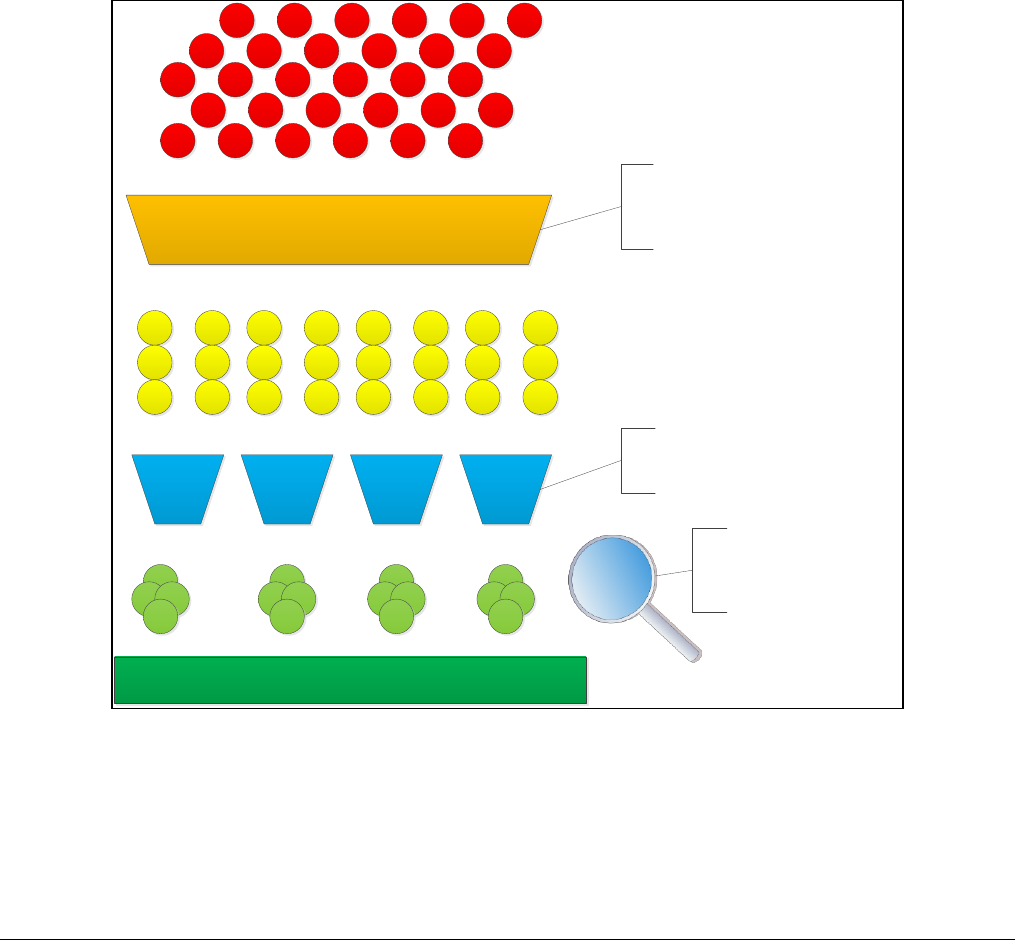
California Department of Technology 28
SIMM Section 170B
Project Requirements Development Instructions August 2016
To perform this filtering and the creation of requirement sets, the controlling inputs are the requirements
context artifacts collected during elicitations, such as the business process flows, stakeholder
classes/groups, defined scenarios, operations and support approaches, etc.
The objective of this initial filtering and setting approach is to allow a more exhaustive and complete
analysis to identify missing or incomplete requirements later in the analysis process. It is virtually
impossible to analyze and find missing, incomplete, conflicting, or other requirement problems in a
large number of individual requirements without partitioning them into subsets around some common
context prior to the analysis. The result is a collection of requirements grouped and has its own unique
context (e.g., a business context for cash management, patient in-processing).
Besides being necessary to perform analysis, it is also critical that the requirements context be
captured with the requirements sets in order to facilitate reviews with the stakeholders, and to provide
improved communications with potential vendors when defined within a solicitation.
Figure 6: View of Requirements Analysis
Set Filter
Indi-
vidual
Filter
Indi-
vidual
Filter
Indi-
vidual
Filter
Indi-
vidual
Filter
All Elicited and other defined
Requirements
Controlling inputs to the set
filter are: Business
processes, stakeholder class/
groups, scenarios, etc
All requirements are reviewed and grouped into sets that are related
to the requirements’ context
The result are sets of requirements with the context for the
requirements retained
All Elicited and other defined
Requirements contained
within sets along with the
requirements context
Controlling inputs to the
individual filters are: definition
of well formed requirements
Each requirement within each set is reviewed.
The result is sets of well formed requirements still with the context
for the requirements within each set retained
Analyze each set for well
formed requirement, missing
requirements, conflicts,
prioritizations, etc.
Resolve Problems, Validate with Stakeholders, and Baseline

California Department of Technology 29
SIMM Section 170B
Project Requirements Development Instructions August 2016
The initial requirement groups will then pass through another filter that reviews each individual
requirement to verify that the requirement text is well formed, meaning the requirement does not use
ambiguous words, is complete, readable and correct (within the requirements set context), and
generally adheres to the controlling inputs, which are characteristics of individual requirements. The
results of this final filtering stage are groups of well-formed individual requirements, with the
requirements context retained. Each group is then analyzed to verify that they as a whole are well
formed, reviewed to identify missing and conflicts between requirements, achieve level-setting
1
of
requirements within the group, and identify prioritizations and other attributes.
After this analysis, problems in the form of requirements gaps in completeness, conflicts or
inconsistency, affordability (not just from a cost perspective, but schedule, risk, M&O, etc.), scope, etc.
will be identified. These problems will be resolved with the stakeholder and stakeholder class/group
that provided the requirement for the requirement context identified with the requirements group. If
conflicts exist between stakeholders or stakeholder classes/groups, they will be resolved in accordance
with the method defined in Section 3.5.2. Once resolved, each requirement set, including the
requirements group context, will be reviewed per Section 3.5.3 and validated per Section 3.5.4 with the
stakeholder and stakeholder class/group that has a legitimate interest in the requirements.
Once validated, the requirements group with all reference material will be baselined and provided to the
requirements management process to control per Sections 3.5.5 and 3.5.6.
3.5.1 Analyze Elicited Requirements
The project needs to define how they are actually going to perform each of the steps identified above
based on the artifacts that they will collect from the requirements elicitation effort and other
requirements either captured within this document or through other defined means. Minimally, define 1)
how requirements will be grouped with the same requirements context, 2) how individual requirements
will be analyzed to ensure they are well-formed, and 3) how each set will be analyzed to ensure the
sets are well-formed.
3.5.2 Resolve Requirements Problems
The project needs to identify the approach they will use to resolve problems identified in the analysis
step. It is extremely important to always keep the requirements context in mind when resolving
problems as well as the entire set of requirements; do not attempt to identify missing requirements with
the stakeholders without presenting the requirements context and the requirements that already have
been identified for the group as this will result in requirements being identified that will likely be
inconsistent with the other requirements in the group. The resolution of problems should not result in
the need to re-work the analysis effort.
It is important to understand that requirements negotiation can be used as a tool. Negotiation might be
needed among stakeholders requiring mutually incompatible features, or when there are conflicts
between desired performance requirements, constraints, available budget, and delivery schedule.
This section must also identify how conflicts between stakeholders and stakeholder classes/groups will
be resolved.
Regardless of how the problems are resolved, the project must identify that records will be kept on how
problems and issues were resolved and by whom or what was agreed.
1
Level-setting of requirements simply means that the requirements within a set are specified at roughly the same
level of detail, except where necessary to be otherwise.

California Department of Technology 30
SIMM Section 170B
Project Requirements Development Instructions August 2016
3.5.3 Provide Feedback
Sometimes agreements cannot be reached on conflicting requirements, unrealistic requirements will
not be changed, or continually requested requirements are beyond the project scope. The project
needs to define how these will be handled. If the project has an issue management or an escalation
process in place, these might be cited. However, if neither of these exists at this point in the project, an
approach must be defined.
3.5.4 Validate Requirements
Describe how the project plans to validate the requirements. As stated previously, it is important to
keep a requirement group and their context together when performing any requirements validation
effort; validation should not be simply a review of a long list of individual requirements as context adds
significant value for understanding what is specifically being required.
The most common way to validate requirements is by performing a series of requirements reviews that
are focused on the requirements context and the individual requirements within that context. For
example, a requirements review session context may be for patient in-processing and all of the
requirements related to this context will be reviewed and validated. As always, issues or action items
are likely to be generated from these meetings so this section must define how these will be captured,
tracked, and resolved.
Finally, the sign-off or formal acceptance or approval of the requirements and issues or action items
must be described within this section; this sign-off or formal acceptance or approval must be made by
the stakeholders that have an interest in the requirement context and the individual requirements
documented.
3.5.5 Document Requirements
This section must identify the documentation that will be kept and maintained throughout the
requirements analysis effort, which will also end up being passed to the requirements management
process for tracking and controlling. While a project may consider keeping little documentation other
than the final requirements, it is important that the document necessary to support the attribute
assessments, at a minimum, be retained. For example, documentation related to the source of the
requirement(s), a requirements priority, issues related to a specific requirement (such as the
stakeholders’ firmness or uncertainty) may relate to a volatility attribute, etc. The project must consider
the attributes that will be kept of the requirements and minimally identify the documentation necessary
to support these attributes and identify them within this section.
Also include here how the final document will capture context in addition to just the requirements. For
example, specify if Use Cases or other types of documents will be used that capture the requirements
context, requirements data, business rules, etc. Again, these are the artifacts that will form the initial
baseline set of requirements that will end up being incorporated into a solicitation. Therefore, they must
communicate the stakeholders’ needs to potential vendors who may not have any understanding of the
stakeholder processes or needs, which adds to the importance of maintaining the requirements context
with the requirements.

California Department of Technology 31
SIMM Section 170B
Project Requirements Development Instructions August 2016
3.5.6 Maintain Requirements Data
The project must identify how the requirements, requirements group, group context, and all additional
supporting information will be delivered to the requirements management process. While the resources
performing both requirements development and Requirements Management may be the same, from a
process perspective, they are different processes. The main point to this description is to specify how
this requirement’s “snapshot in time” will be captured in order for the transferred artifacts to be
complete. In practice, requirements are typically approved incrementally and transferred as each group
is approved. Therefore, if this approach is going to be used, it must be described here. However, a
word of caution is that once passed to the Requirements Management process, the requirements are
baselined and cannot be changed without change control procedures being followed.
If an approved requirements group is passed to Requirements Management and a later review of a
different group identifies a problem with the already approved, baselined group, then a change request
should be created.
4. Requirements Management
The purpose of the Requirements Management Plan is to describe the roles and responsibilities for
Requirements Management and the activities and tasks that will be performed as part of this
Requirements Management effort. The activities and tasks include:
Creation of a controlled and managed requirements repository
Capturing approved project requirements within the repository
Assessing and controlling changes to the baseline requirement
Creation of metrics and reports
The Requirements Management Plan addresses the management, assessment, and control of
changes to project requirement baselines (specifically, the requirements contained within each
baseline, over the entire development lifecycle, consistent with ISO/IEC/IEEE 16326-2009, to increase
the probability of a project’s success).
4.1 Relationship to other Project Management Plans
The project should describe the relationship of the Requirements Management Plan to the other project
plans that have been or will be created for the project. This can be done multiple ways, by identifying
the other plan and how they are related or graphically display the relationship. For example:
Change Management Plan:
The Change Management Plan identifies the process and controls that will be enforced on the
project to manage changes to the requirements. As a change is being considered, an
assessment of the impacts of the change will be made that will include the assessment
described within this Plan. After a change is approved, the change will be incorporated into the
requirements baseline as described within this Plan.
The objective is to provide a clear understanding of how this Requirements Management Plan
integrates with the other Project Management Plans.

California Department of Technology 32
SIMM Section 170B
Project Requirements Development Instructions August 2016
4.2 Roles and Responsibilities
The project should describe the specific roles and responsibilities as they have been tailored for
requirements management activities. These are not meant to be general job descriptions for the role
but rather a summary of the responsibilities for each role with respect to requirements management
and the activities and tasks described within this Plan.
Table 7: Roles and Responsibilities for Requirements Management
TITLE
ROLE
RESPONSIBILITY
Project
Executive
Steering
Committee
The Executive Steering
Committee’s role is to ensure that
the baseline requirements are
being managed in accordance with
this Plan and that the traceability is
complete and all issues with
traceability are being resolved.
The Executive Steering Committee is
responsible for reviewing the Requirements
Management reports provided to the Committee
in accordance with this Plan and for
understanding the effects of all open issues with
traceability and the consequences of the
identified effects. They are also responsible for
ensure that the Project Manager has a sound
plan for resolving all open issues or mitigating
the impacts and for resolving issues that have
been escalated to the Committee regarding
requirements.
Project
Executive
Sponsor
The Project Executive Sponsor’s
role is to ensure this Plan is
executed in a timely and efficient
manner and that the objectives are
reached.
The Executive Sponsor will provide the
necessary support to the Project Manager to
ensure that state and vendor resources are
available to support the execution of this Plan
and to provide the necessary support to ensure
the vendor is providing the necessary artifacts
and Requirements Management efforts to
support this Plan, in accordance with their
contract.
Project
Business
Sponsor
The Business Sponsor’s role is to
provide the overall business
leadership to ensure the
requirements baseline is
maintained, that requests for
requirements changes have
followed the approved Change
Management process, and that
approved changes to the baseline
have been timely incorporated into
the requirements baseline.
The Business Sponsor is responsible for
reviewing the Requirements Management
reports to ensure that the requirements baseline
is complete, that all approved changes have
been incorporated, and the impacts caused by
these changes are identified within the
repository.

California Department of Technology 33
SIMM Section 170B
Project Requirements Development Instructions August 2016
TITLE
ROLE
RESPONSIBILITY
Project
Director
The Project Director’s role is to
provide support for the Project
Manager to aid in removing
obstacles and resolving
issues/problems that are beyond
the Project Manager’s span of
control.
The Project Director is responsible for tracking
the progress of the Requirements Management
effort by reviewing the Requirements
Management reports generated and the issues
that are indicated within the reports. The
Director is responsible for ensuring that the
Project Manager has a sound, timely, and
reasonable approach for resolving the identified
issues.
Project
Manager
The State Project Manager’s role
is to ensure the overall
Requirements Management effort
is being executed in accordance
with this Plan.
The state Project Manager is responsible for
ensuring that the entire project team, state and
vendor, are following this Plan and for ensuring
all of the other project processes that interact or
provide input to the requirements management
effort are being adhered to. The Project
Manager is also responsible for ensuring that
there are sufficient resources to execute this
Plan and that the requirements management
activities are being performed in a timely
manner.
Vendor
Project
Manager
The Vendor Project Manager’s
role is to ensure the vendor team
is complying with the
Requirements Management
process and procedures within this
Plan and in accordance with the
requirements in the vendor’s
contract.
The Vendor Project Manager is responsible for
performing reviews of the Requirements
Management work being performed by the
vendor team and to verify that the work complies
with the requirements management process
described in this Plan and the requirements in
the vendor’s contract. The Vendor Project
Manager is responsible for identifying issues to
the state Project Manager timely to minimize the
amount of rework necessary for the state and
the vendor teams.
State
Requirements
Manager
The State Requirements
Manager’s role is to provide the
leadership for the overall
Requirements Management
process and assume the sole
ownership of the entire
requirements repository.
The State Requirements Manager is responsible
for the overall requirements management effort
and the requirements repository containing the
requirements baseline. This person is
responsible for ensuring that the requirements
managed by this Plan are organized, managed,
and controlled and that any and all issues are
identified and resolved in a timely manner in
order to minimize rework.

California Department of Technology 34
SIMM Section 170B
Project Requirements Development Instructions August 2016
TITLE
ROLE
RESPONSIBILITY
Vendor
Requirements
Manager
The Vendor Requirements
Manager’s role is to perform the
Requirements Management
activities and tasks assigned in
accordance with this Plan and the
vendor contract.
The Vendor Requirements Manager is
responsible for ensuring that all work performed
in the requirements repository by the vendor
team complies with the process and procedures
defined within this Plan. They are also
responsible for ensuring that issues that impact
the requirements management effort that are
part of the vendor’s responsibility are identified
early and resolved in order to keep the
repository current and/or minimize rework.
4.3 The Requirements Management Process
The requirements management process defined herein is consistent with the requirements defined in
ISO/IEC/IEEE 16326-2009. Included are establishing the mechanisms for changes to requirements,
assessing the impact of requirements changes. The controlled requirements repository should have
already been created where changes can be measured and reported. Within the requirements
repository, the requirements will be baselined and requirements traceability, that relates mid-level
solution requirements to detailed solution requirements and artifacts, will be performed.
4.4 Establish a Controlled Requirements Repository
A controlled requirements repository is critical for requirements management. Project requirements will
change! In order to ensure that these changes are managed and that all areas impacted by the
changing requirements know about the change, plan their work with knowledge of the changed
requirements, re-plan their work that may already be in progress due to the impacts of the change, or
plan for re-work due to the change occurring after the work was already done. The only method to fully
understand the impact of change is to maintain a tightly controlled requirements repository that also
supports traceability, which will be discussed later. However, without a controlled requirements
repository, no traceability can be performed.
4.4.1 Requirements Repository
The requirements repository is a database, spreadsheet, file system, or other data storage system that
is created through the use of a tool where the project requirements will be maintained. The repository
establishes and defines the projects’ requirements baseline at any time throughout the project lifecycle.
The repository incorporates the project approval requirements, solicitation/contractual requirements
(contract baseline), and extends them based on approved changes and further refinement and
elaboration as the project progresses through its development lifecycle. Every phase of the project
lifecycle builds upon and/or elaborates on the requirements baselined and captured in the repository
from the previous phase and the lifecycle phases correspond to the levels defined within the
requirements repository.
Therefore, the requirements repository captures the results from the current level/phase to support the
next level/phase and defines what must be addressed in the next level/phase. Further, the repository
identifies what must be tested for all test levels and is the source for developing test cases/scripts.

California Department of Technology 35
SIMM Section 170B
Project Requirements Development Instructions August 2016
The repository must be capable of incorporating all of the requirements from all levels/phases of the
project. The repository must also be auditable in order to be able to identify if any requirement has
changed and be capable of identifying the impacts of a change to lower level requirements and to test
cases/scripts. Since the requirements repository plays such a vital role in the development of a system,
it must be constantly managed, maintained, and controlled.
Identify the tool that will be used to hold the requirements repository. Identify how the tool will be
organized, physically, how artifacts will be captured within the tool, what requirement attributes will be
used at each Level, how traceability will be performed within the tool, both horizontally and vertically,
and the specifics on how access and security will be controlled and maintained. If standard
organizational policies will not be placed on the tool, specifically backup/recovery, security, etc., and
describe how these will be accomplished. Also describe the approach to tagging (the unique
numbering of requirements at each Level of the requirements).
4.5 Create Requirements Baseline
Upon the approval of a requirements artifact, the artifact will be loaded into the requirements repository,
individual requirements identified and tagged, and the requirements’ attributes set in accordance with
the following procedures.
Identify the procedures for the Requirements Manager/Analyst to:
1) Load the requirement artifact into the tool
2) identify and uniquely tag the requirements, preserving the internal relationships between
requirements
3) Set the requirement attributes.
Since the procedures to do this are dependent on the tool that will be used, detailed instructions must
be provided by the project. However, the purpose of loading the requirement artifact is so that the
artifact that forms the baseline of the requirements is captured and controlled within the repository. The
reason for identifying and tagging requirements is to have a consistent method for determining what is
and what is not a requirement within the requirements artifact; tagging allows a unique numbering or
identification to be made for each requirement, which will be heavily used for traceability.
The purpose of determining and assigning attributes is to characterize each requirement. Common and
standard attributes are items such as risk, priority, criticality, complexity, cost, status, business area,
etc., and are more typically assessed in levels, such as High, Medium, and Low. Attributes support the
reporting, generating of metrics, and change assessments so they are important to identify and assess
when reviewing the individual requirements.
Again, these should be repeatable procedures, not guidance or a narrative. A quality assurance/quality
control organization should be able to verify if these procedures are being followed or not. At a
minimum, there are three (3) procedures required for this section.
4.5.1 Load Requirements Baseline
Determine the procedure that describes what is required to load the requirements artifacts into the
repository. Be specific but do not describe different procedures for every requirements artifact. It is
more common to describe procedures based on the document type, (e.g., MS Word, MS Excel, and MS
Access). However, only describe the procedures necessary and supported by the Deliverable
Expectation Document (DED) for the deliverables; if the project only allows deliverables to be submitted
in an MS Word format, then only describe the procedures for artifacts that are in MS Word.
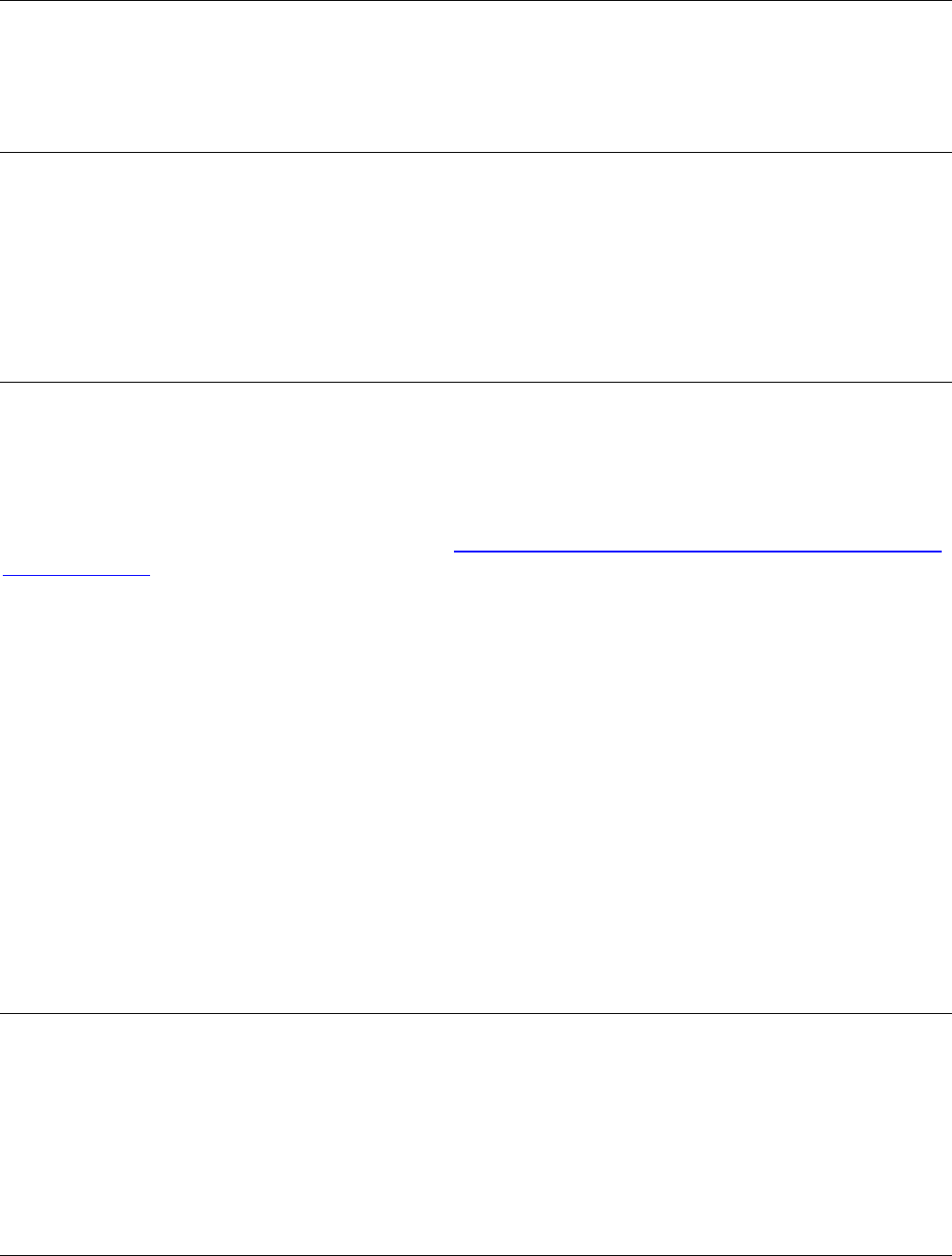
California Department of Technology 36
SIMM Section 170B
Project Requirements Development Instructions August 2016
4.5.2 Identify and Tag Requirement
Identify how requirements will be identified within each Level of the requirements. This may consist of
looking for key words, such as shall or must, or if the requirements are not documented consistently
this may need to be more general direction but the direction must be sufficient to obtain repeatable
results. Then, identify the procedures for tagging the requirements at each Level.
4.5.3 Set Requirement Attributes
Identify the procedures for setting the requirement attributes at each Level of the requirements. Clearly
identify mandatory attributes that must be set (e.g., Status, Criticality, Owner), as well as optional
attributes. A word of caution though on optional attributes is that these cannot be reliably queried for
reporting purposes as they may not be set consistently. For example, if the Owner attribute identifies
who is responsible for providing the requirement (State or vendor) and this attribute is optional, it would
not be possible to run a reliable query to separate the contractual requirements from the non-
contractual requirements.
4.6 Perform Requirements Traceability
A Requirement Traceability Matrix (RTM) shall be used to track and link each individual requirement
from its origin through the development lifecycle. This matrix is used to track the requirements and to
check that the current project requirements are met. The RTM captures all requirements proposed by
the project stakeholders and their traceability in a single deliverable at the conclusion of the project life-
cycle. In other words, it is a document that maps and traces user requirement with test cases. The main
purpose of Requirement Traceability Matrix is to see that all test cases are covered so that no
functionality is missed while testing. Refer to the SIMM Section 17 CA-PMF Requirements Traceability
Matrix Template.
Vertical traceability will be performed from the PAL through to the Code Level. Horizontal traceability
shall be performed from the Code Level to the Unit Test Level, Design Level to the Integration Test
Level, Requirement Analysis Level to the System Test Level, and from the Project Level to the User
Acceptance Test Level and Deliverables Level.
Identify the specific procedures for performing traceability. Since the steps for performing traceability
are dependent on the tool being used, at least at the procedure level, this section must be written for
the specific tool being used. It is critical that both downward/forward and upward/backward traceability
be documented. When using a Requirements Management tool such as Requisite Pro, both
downwards and upwards traceability will be performed automatically by creating a single relationship.
However, if using MS Excel or some other similar tool, both of these relationships must be established
manually. Also, identify the post-traceability steps to ensure the completeness of the traceability, (i.e.,
nothing was skipped or missed). Also, traceability to the verification Levels must be defined. When a
requirement change is approved, the requirements baseline shall be modified to incorporate the
change, which will create a new requirements baseline.
4.7 Managing Requirements Change
After the requirements for each Level are accepted, the requirements are baselined, loaded into the
requirements repository, and any change to these requirements will be prohibited unless formally
approved by the Project Change Management Plan processes. The requirements management
activities defined within this Plan, in support of the Change Management process, are 1) to perform an
impact analysis to identify the impact(s) of a proposed change to other baseline requirements at all
Levels, 2) to formally capture and update the approved baseline change(s), and 3) to verify that all
traced requirements, and their associated artifacts, are also updated to ensure that traceability is still
complete, correct, and consistent after the change has been made to the repository.

California Department of Technology 37
SIMM Section 170B
Project Requirements Development Instructions August 2016
4.7.1 Requirements Change Impact Assessment
The following is an example for what the project must consider when developing the procedures for this
section. It can be tailored for the specific project, re-written with the following content, deleted, or
moved to an appendix for use as a general overview. Regardless, the project must document the
procedures on how requirement modifications, additions, and deletions will be addressed.
Per the Project Change Management Plan, when a request for a change has been submitted and
reviewed, an impact assessment will be requested. The requirements management process will
provide input into the impact assessment by identifying all of the requirements and artifacts that will be
impacted (potentially also requiring a change to be consistent with the proposed requirement change)
by the proposed change and if requirements traceability will still be complete if the change is approved.
The requirements management process is not responsible for evaluating the technical, business,
management or other need for the change or the value of the change to the organization. The
requirements management process assesses the scope of the impacts of the change on other baseline
requirements and if traceability will still be complete if the change is approved. This is done by
identifying the traceability relationships of the existing requirement proposed to change to all other
baselined requirements and artifacts that the requirement is traced from (i.e., parent requirements), or
traced to (i.e., children requirements).
As can be seen in Figure 7, if a Project
2
Level requirement (R X.2) is proposed to be modified (R X.2
m
)
and the project has approved a Project Approval Level requirement and a Requirements Analysis Level
requirement that are traced to the Project Level requirement, then its parent requirement within the
Project Approval Level (e.g., FSR) shall be identified (R X), all of the children of this parent requirement
shall be identified (R X.1 and R X.2), and the children requirements of the requirement being modified
(R X.2) within the Requirements Analysis Level shall be identified (R X.2.1 and R X.2.2). The
requirements management process shall perform the following actions:
1. Identify the parent requirement (R X) of the existing requirement (R X.2) and all children of this
parent requirement (R X.1 and R X.2)
2. Assess if the modified version of the requirement (R X.2
m
) is still consistent and within the scope
of its parent requirement (R X)
o Identify if the modified requirement is still consistent with and within the scope of the
parent requirement; if not, then report that the parent requirement may also need to be
modified.
3. Assess if the children (R X.1 and R X.2
m
) of the parent requirement still satisfies all of the needs
of the parent requirement (R X)
o When considering all of the children together, identify if the scope of the parent
requirement is satisfied by all of the children; if not, then report that additional changes
are needed to either the children requirements or to the parent.
4. Identify the children requirements (R X.2.1 and R X.2.2) of the requirement being modified (R
X.2)
5. Assess if the children of the requirement (R X.2.1 and R X.2.2) are consistent, within the scope,
and fully satisfy the modified requirement (R X2
m
)
o Identify if the children of the existing requirement are still valid for the modified version
and if the children are still consistent, within scope, and when considered together still
satisfy the modified version of the requirement; if not, then report that additional changes
may be needed.
2
Within this section, it is assumed that the State assumed requirements, RFP requirements, and the contract
requirements are maintained within the requirements repository as one (1) level, which is being termed as the
“Project” level.
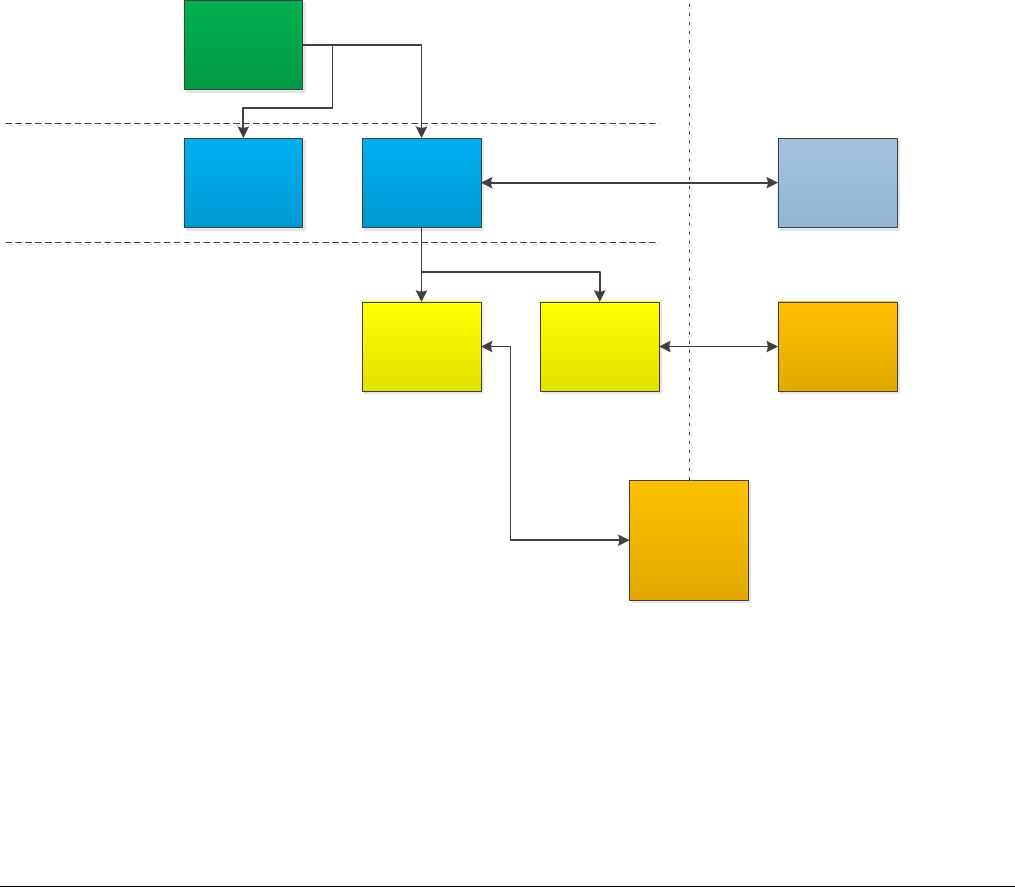
California Department of Technology 38
SIMM Section 170B
Project Requirements Development Instructions August 2016
6. Identify the relationship between the identified requirements and test artifacts impacted at all
test Levels (R X.2 ⇒ UAT X.2.1 and R X.2.2 ⇒ ST X.2.2.1) and other artifacts/Deliverable (R
X.2.1 ⇒ Training Manual) that are traced to any of the requirements potentially impacted by the
proposed change
o Report the relationships to the test and deliverables that exist for the original
requirement. Requirements management is not responsible for determining if there is an
impact to these items but the relationships must be provided back to the Change
Management Impact Analysis owner for them to review and determine if any additional
impacts exist.
7. Report the identified potential impacts and the results of the assessments back to the Change
Management process so that they can be considered prior to deciding on the change.
It is not within the scope of the Requirements Management Plan to assess and determine if an impact
exists as this may be beyond the capabilities of the requirements management team. Requirements
management only reports that a potential impact exists, which must be further examined and
determined by the resources performing the impact assessment for Change Management.
Figure 7: Modified Requirements Assessment
R X
R X.2.1
R X.2
R X.2.2
Project
Approval
Level
Project
Level
Requirements Analysis
Deliverable
UAT Test
Case/Script
UAT X.2.1
Deliverable
Artifact, e.g.
Training
Manual
System Test
Case/Script
ST X.2.2.1
R X.1
See Figure 8 for a scenario in which a requirement is being added (R Y.NEW) to the Project Level and
where a parent requirement, children requirements, test cases/scripts, and/or deliverable must also be
identified. To add a new requirement, the following process shall be executed:
1. Identify the parent requirement within the set of baseline Project Approval Level (e.g., FSR)
requirements that identifies the scope or high-level requirement associated with the proposed
new requirement (R Y.NEW)
o If a parent requirement does not exist then report that a parent requirement must also be
added as part of the change request
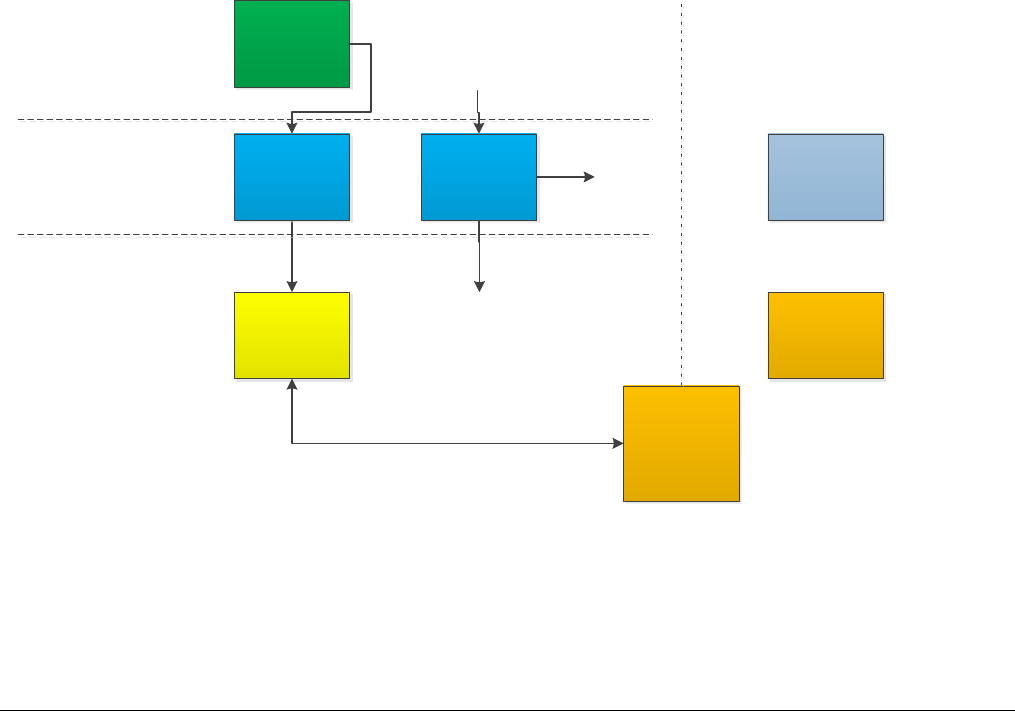
California Department of Technology 39
SIMM Section 170B
Project Requirements Development Instructions August 2016
2. If a parent requirement exist, for this example assume the parent is RY, assess if the children (R
Y.1 and R Y.NEW) of the parent requirement (R Y) still satisfy the needs of the parent
requirement and that the children are within the scope of the parent and the children are not
duplicative
o If the new requirement is beyond the scope of the parent requirement, duplicative of
other children requirements of the parent, or the parent requirements is still not satisfied
by all of the children requirements then report that additional changes should be
included in the change request.
3. Identify the requirements within the Requirements Management repository that the new
requirement should trace to and if the lower-level requirements are present.
o If traceability has been performed to the next Level, to verification, or to deliverables,
then identify and report if there are missing children requirements, missing test
cases/scripts, and/or missing deliverables, if any are required. (Note: Only identify
missing requirements, test cases/scripts, and deliverables if traceability has been
performed to these items. For example, if UAT Test Case/Scripts have not been
developed and therefore not traced to, then the fact that the new requirement cannot be
traced to UAT Test Case/Scripts in irrelevant and does not need to be reported.
Similarly, if the Requirements Analysis Level requirements have not been baselined then
there is no need to identify that there are no children requirements for the new
requirement.)
4. Report the identified potential impacts and the results of the assessments back to the Change
Management process so that they can be considered prior to deciding on the change.
Figure 8: Added Requirement Assessment
R Y
R Y.2.1
Project
Approval
Level
Project
Level
Requirements Analysis
Deliverable
UAT Test
Case/Script
UAT X.2.1
Deliverable
Artifact, e.g.
Training
Manual
System Test
Case/Script
ST X.2.2.1
R Y.1 R Y.NEW
?
?
?
See Figure 9, for a scenario where a requirement (R X.2) is being deleted. If a requirement is being
deleted, the Requirements Management process must verify that the requirements’ parent requirement
(R X) is still being fulfilled by other child requirements (R X.1) and that all of the requirements’ child
requirements are also deleted, assuming they only have one parent requirement. To delete a
requirement, the following process shall be executed:
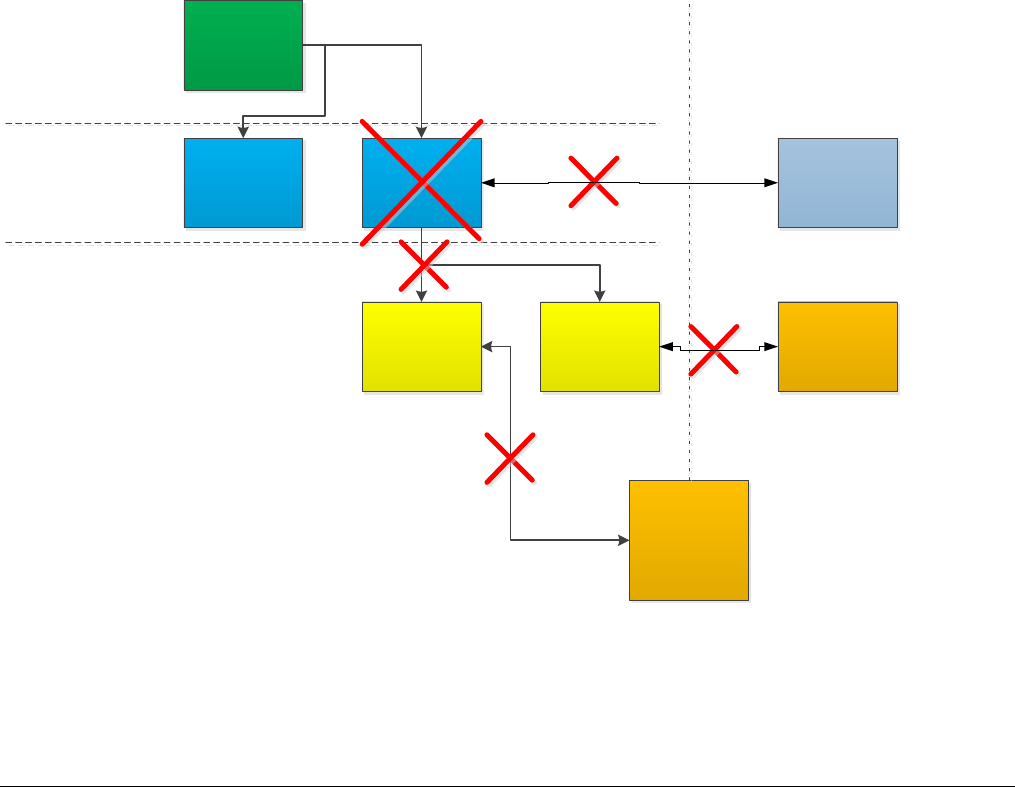
California Department of Technology 40
SIMM Section 170B
Project Requirements Development Instructions August 2016
1. Identify the parent requirement (R X) of the requirement being deleted (R X.2) and all children of
the parent requirement (R X.1 and R X.2)
2. Assess if the remaining children (R X.1) of the parent requirement (R X) still satisfies all of the
needs of the parent requirement
o Identify if the remaining children requirements still provide all of the needs required by
the parent requirement; in not, report that additional changes are needed to either the
parent requirement, or the other children requirements must be modified, or a new
requirement is needed.
3. Identify the children (R X.2.1 and R X.2.2) of the proposed deleted requirement (R X.2), the
artifacts they are documented within (e.g. the contract), and the test case/scripts and
deliverables that would be impacted and need to be updated should the requirement and
children be deleted.
o For the traceability that has been completed, trace the proposed deleted requirement
down to its children and to the test cases/scripts and deliverables to identify if the
children requirements and/or test cases/scripts must also be deleted and if the
requirement traces to a deliverable that must also be updated to remove the
requirement. If additional changes are required, report these additional changes.
4. Report the identified potential impacts and the results of the assessments back to the Change
Management process so that they can be considered prior to deciding on the change.
Figure 9: Delete Requirement Assessment
R X
R X.2.1
R X.2
R X.2.2
Project
Approval
Level
Project
Level
Requirements Analysis
Deliverable
UAT Test
Case/Script
UAT X.2.1
Deliverable
Artifact, e.g.
Training
Manual
System Test
Case/Script
ST X.2.2.1
R X.1

California Department of Technology 41
SIMM Section 170B
Project Requirements Development Instructions August 2016
4.8 Updating Baseline Requirements
Once a change is approved, the requirements baseline within the repository must be updated. This
includes loading the approved change request into the repository, identifying its requirement(s), setting
the attributes, and then updating the traceability links between the requirement, its parent
requirement(s), children requirement(s), test cases/scripts, and deliverables that were identified as
impacted in the Section 4.7.1 Requirements Change Impact Assessment.
Common to the modification, addition, or deletion of a requirement is the need to capture the approved
change request and its requirement. The following procedures are the steps to capture the approved
change request, identify and tag its requirements, and set its attributes.
NOTE: Include the procedures to 1) load the approved change request into the repository, 2) identify
and tag the requirement(s) within the change request, and 3) set the requirement attributes.
Once this procedure is completed, the one of the following procedures shall be performed, depending
on the type of change, to modify, add, or delete a requirement.
4.8.1 Modification Update
If a requirement is being modified, it is important to note that related/traced requirements and artifacts
will likely not be submitted at the time the change request is approved or when updating the
requirement. Therefore, when the requirement is being modified within the repository, all traceability
links must be flagged as “suspect.” Then, each “suspect” link needs to be re-verified, either after a
parent or child artifact is updated and approved and the impacted parent/child requirement is updated
or, upon further analysis, the existing traceability relationship is still deemed valid.
Identify the procedure for modifying the requirement, changing all of the traceability links to suspect, re-
assessing the requirement attributes, and re-verifying all of the traceability links. Critical within the
procedure is the ability to maintain configuration control so that previous data is retained.
4.8.2 Addition Update
If a requirement is being added, then the requirement is added to the requirements repository into a
Level/location appropriate for the structure of the repository and below the Level where the traceability
relationship to a parent requirement will be established. Again, if the parent Level does not contain a
requirement in which to trace the new requirement then no traceability link can be established until a
new parent Level requirement is approved. Similarly, links to children requirements must be
established, which may also require leaving the traceability relationship blank until the child artifact(s)
and their associated requirements are updated and approved.
Identify the procedure for adding a requirement, how and where to add the requirement, assessing the
requirement attributes, and establishing the traceability relationships/links.
4.8.3 Deletion Update
If a requirement is being deleted, the requirement within the requirements repository is only logically
deleted by setting an attribute, such as Status, to “Deleted”; requirements themselves are never
physically deleted. Therefore, the requirement’s attribute is set to logically delete the requirement. The
traceability link to the parent requirement is physically deleted as are the links to the children
requirements. The children requirements are not deleted unless the artifact in which they are
documented is updated and approved to delete them. Then, once the child artifact is updated and
approved that deletes the child requirements, the child requirements are logically deleted and the
traceability relationships between each of them and other requirements, test cases/scripts, and
deliverables are also deleted.

California Department of Technology 42
SIMM Section 170B
Project Requirements Development Instructions August 2016
Care must be used in deleting requirements due to the potential cascade effect, meaning that by
deleting a requirement at one Level may cause the deletion of all of its children, test cases/scripts and
require a deliverable update, and each child may also have children, test cases/scripts, and
deliverables that must be deleted or updated, and so on. This cascade effect must be carefully traced
to avoid significant re-work to re-establish correct and valid traceability.
Identify the procedure to logically delete a requirement and to delete the traceability relationships/links.
4.9 Requirements Traceability
Once requirement sets from adjacent levels have been loaded, traceability shall be performed.
Traceability shall establish relationships between higher level requirements (e.g., a requirement in the
Project Approval Level) to lower level requirement(s), (e.g., one or more requirements in the Project
Level). Within this Plan, higher level requirements are called the parent requirements of the lower level
requirements and the lower level requirements are called the child or children requirements of the
higher level requirement. Each parent requirement must have one or more child requirement(s) and a
child requirement must have a parent requirement. By establishing a relationship between artifacts at
different Levels, the project can ensure that all of the higher level requirements have been addressed
and accounted for in the lower level requirements, which is termed downward traceability. Further,
traceability ensures that all lower level requirements are actually required to meet the needs of a higher
level requirement, which is termed upward traceability. Therefore, when a proposed change to a
requirement is being considered, traceability can and will be used to identify all of the impacts
associated with the change, both upward and downward.
When a requirement change is approved, the requirements baseline shall be modified to incorporate
the change, which will create a new requirements baseline. The requirements baseline is kept and
maintained within the requirements repository, not externally. Therefore, when a change request is
approved, the change must be made in the requirements repository. Configuration control and security
shall be maintained. Be sure to indicate how configuration control and security will be invoked in order
to maintain the previous baseline, how the new baseline will be established, and how unauthorized
access and ability to make changes will be prevented. If using a tool like MS Excel, this is a manual
process whereas if using Requisite Pro, the history and version control and the security are provided by
the tool itself.
Finally, when performing activities such as assessing the impact of a proposed requirements change,
creating metrics, or generating status reports, the requirements repository is accessed in a read-only
mode. Again, based on the tool that will be used, describe how read-only users will access the
repository to collect the data necessary to perform these three functions.
The following figure, Figure 10, graphically illustrates the relationships between and amongst various
requirements Levels and general artifacts of a typical project. On the left-hand side of the figure are the
requirement Levels and artifacts/requirement types. The requirement types are requirements that are
documented in various artifacts, such as the project approval document (e.g., PAL S2AA) documents
project approval type requirements, vendor contract documents contract type requirements, etc. On
the right-hand side are verification Levels and artifacts. The artifacts are items such as test
cases/scripts for each of the different Levels of testing as well as deliverables that have been
approved/accepted.
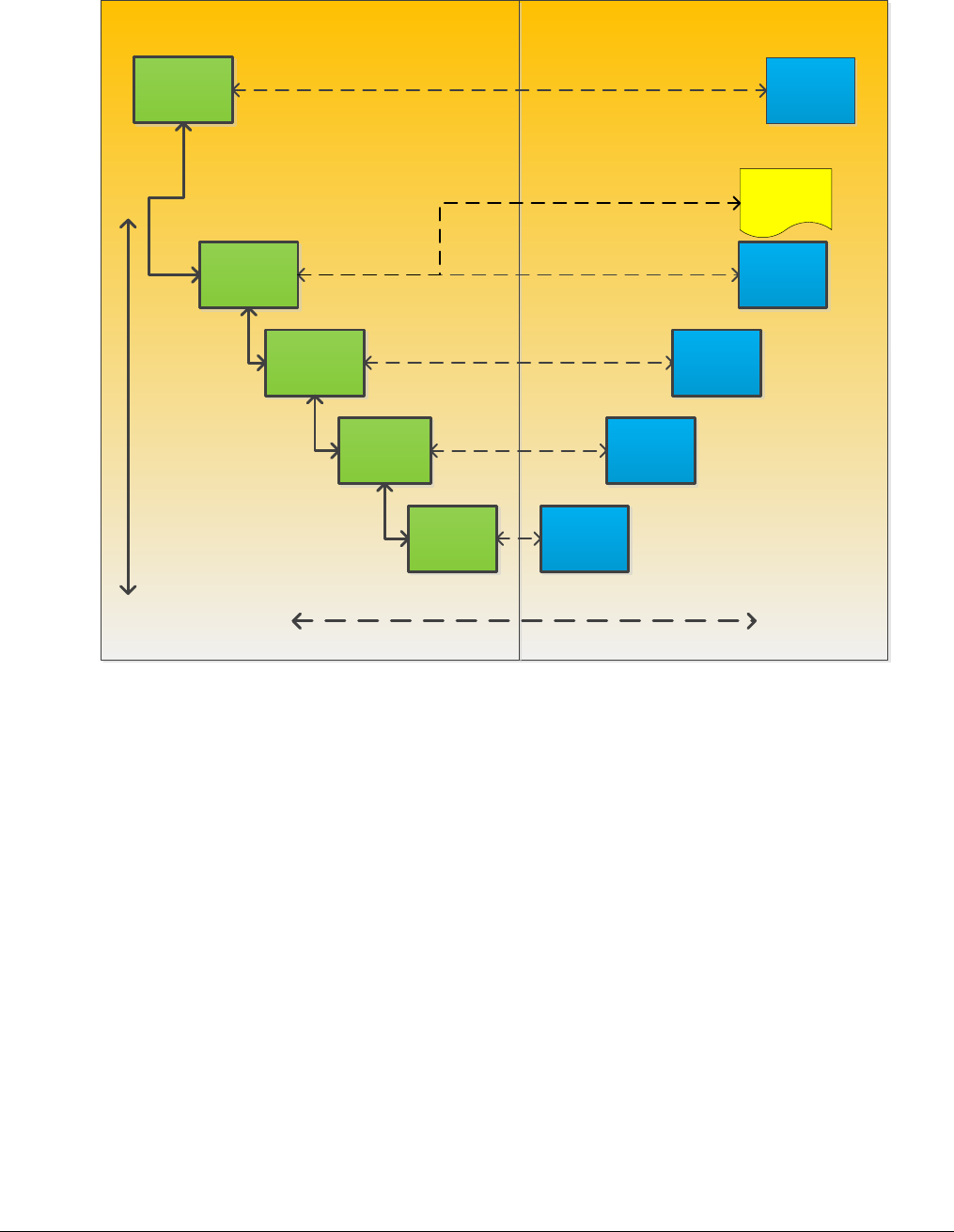
California Department of Technology 43
SIMM Section 170B
Project Requirements Development Instructions August 2016
Figure 10: V-Model Example
Project
Approval
Requirements
Contract
Requirements
System/
Software
Requirements
Design
Specifications
Source Code
Unit
Testing
Integration
Testing
System
Testing
User
Acceptance
Testing
Requirements
Verification
Vertical Traceability
Horizontal Traceability
PIER
Deliverables
Project Approval Level
Project Level
RA Level
Design Level
Code Level
Vertical Traceability, as shown in Figure 10 on the left and by the solid arrows between the
requirements Levels, is the identification of a requirement at one Level and how that requirement
relates to a requirement at another Level. As an example, a specific contract requirement at the Project
Level, say C1 in Figure Error! Reference source not found.11, may be further elaborated by
equirements identified in the System/Software Requirements document, RA1, RA2, and RA3 within the
Requirements Analysis (RA) Level. Vertical Traceability identifies this relationship and establishes a
link, which is a reference that points from the individual contract requirement to a specific System
Software Requirements document requirement. In practice, there is typically a one-to-many
relationship, meaning one contract requirement is often related to one or more System/Software
Requirements; this one-to-many relationship is also called the fan-out of N for the contract requirement,
where N is the number of requirements related to or linked to the contract requirement. In Figure 11,
Requirement PR1 has a fan-out of 3. This tracing, while vertical tracing, is also commonly called
Downwards Traceability.

California Department of Technology 44
SIMM Section 170B
Project Requirements Development Instructions August 2016
Figure 11: Fan-out and Fan-in Example
PR1 PR2 PR3
RA2 RA3 RA4 RA5RA1
Project Level
Requirements
Analysis Level
In addition to Downwards Traceability, Vertical Traceability also encompasses Upwards Traceability, as
shown in Figure 10 and Figure 11 by the arrows also pointing upward. Upwards Traceability is
performed by establishing a relationship between every lower Level requirement to a higher Level
requirement. For example, each requirement in the Requirements Analysis Level must be related to a
requirement in the Project Level, and a traceability link is established to capture this relationship.
Notice in Figure 11 that RA1, RA2, and RA3 are all linked to requirement PR1; from RA1’s perspective,
it has a fan-in of 1 because it is linked to only one higher level or parent requirement. Occasionally, the
fan-in may be greater than one as shown in Figure 11 for RA4, which is more prevalent when
performing traceability to verification/test artifacts and deliverables discussed later. Note that RA5 does
not have a traceability link identified. This means that either traceability is not complete or the RA5
requirement is not necessary and should be deleted as is does not support any approved need; this is
also called “gold plating,” which is adding additional requirements that are not required but may be nice
to have.
By using a Requirements Traceability tool, the effort required to establish the relationships for
traceability is greatly simplified. When using these tools, if a link or relationship is created between a
higher Level requirement and a lower Level requirement (downwards), a link is also automatically
created between the lower Level requirement and the higher Level requirement (upwards). After
Downwards Traceability is complete, the only effort required for Upwards Traceability is to verify that all
lower Level requirements have been traced.
Horizontal Traceability is similar but this traceability is between requirements at one Level to the artifact
(a test case and/or script) that verifies the requirement. For most requirements, this will be performed
between individual requirements at each Level of the requirements hierarchy on the left side of Figure
10 to a test case/script on the right side of the figure. However, some requirements within the Project
Level, specifically from the contract, identify deliverables that must be accepted by the state (e.g., a
Training Manual). Therefore, these Project Level requirements are traced to a deliverable and not to a
test case/script
3
. As shown in Figure 10, this traceability is also bi-directional, meaning that testing
should only be verifying baselined requirements, though some exceptions
4
can and do occur.
3
A test case/script could be created for deliverables but this is generally not done; therefore, in order to complete
the traceability, the requirement must be traced to the deliverable itself.
4
Test cases and scripts may be developed for validation reasons (meaning will the system work for the current
business) that do not directly tie or relate to baseline requirements. While this is done, care must be used
because a defect from these types of tests does not imply that the system does not meet its requirements; the
defect may be beyond the scope of the requirements and require a relatively expensive change request to
implement.
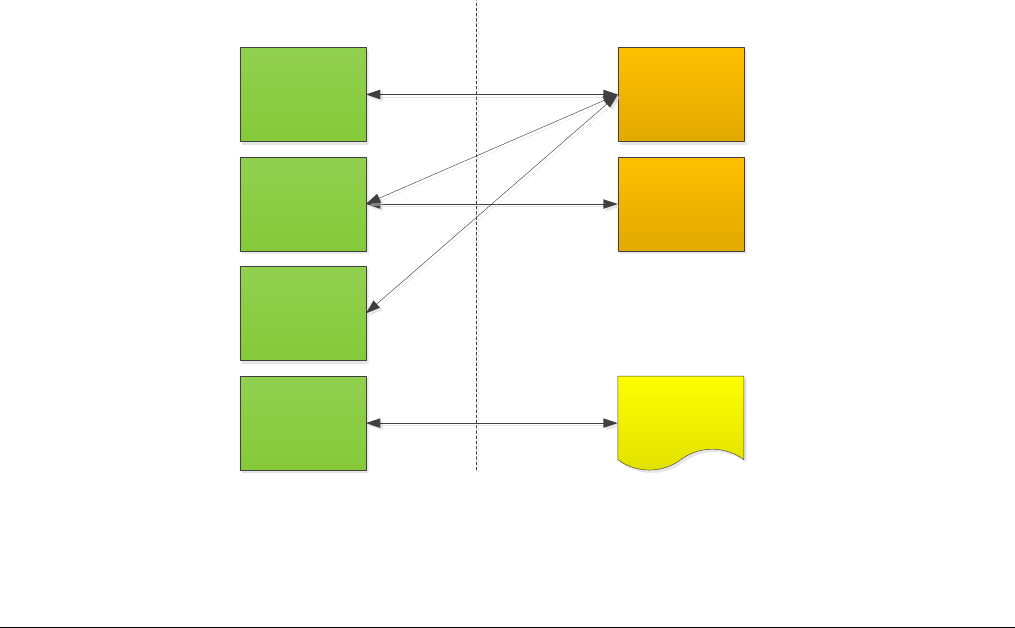
California Department of Technology 45
SIMM Section 170B
Project Requirements Development Instructions August 2016
Figure 12 (below) illustrates Horizontal Traceability between Project Level requirements and User
Acceptance Test Cases/Scripts and Deliverables. In this example, requirement PR1 is traced only to
UAT1, which means that the test case/script UAT1 verifies the entire PR1 requirement. Also note that
UAT1 verifies part of the PR2 requirement and the entire PR3 requirement. This can be determined
based on the fan-out of the Project Level requirements to the test cases/scripts. By looking at the fan-
in of the test cases/scripts, it is evident that UAT1 supports the verification effort for three Project Level
requirements whereas UAT2 only supports one Project Level requirement.
While bi-directional traceability is important for a number of reasons, one of most obvious reasons from
a testing perspective is that if UAT1 is blocked or unable to execute, then this blockage is preventing
the verification of three Project Level requirements; if UAT2 is blocked it is only blocking the verification
of one Project Level requirement. Therefore, a Project may want to put more priority on getting UAT1
unblocked than UAT2 so more Project Level requirements can be verified. Also, if test case/script
UAT1 needs to be modified then any modification must take into account all three of the linked
requirements so that the requirement are still being verified by the test case/script; UAT2 only needs to
be concerned with the PR2 requirement. A common situation is that a Project Level requirement is
changed and will require a change to the test case/script; therefore, knowing the test case/script that
verifies the changing requirement and all of the other requirements verified by the test case/script is
essential in order to make the change to the test case/script and still ensure the test case/script verifies
all of the requirements traced to it.
Project Level requirement PR4 traces to a deliverable, D1. While this type of traceability is not required
to be bi-directional, it is generally best practice to use bi-directional traceability for baselined deliverable
changes due to requirement changes. Requirements Traceability tools establish bi-directional
traceability automatically, by default, so when these tools are used there is no additional work or effort
required to perform bi-directional traceability.
Figure 12: Horizontal Traceability Example
PR1
PR2
PR3
UAT2
UAT1
Project Level
Requirements
User Acceptance
Test Level
D1
Deliverables
PR4

California Department of Technology 46
SIMM Section 170B
Project Requirements Development Instructions August 2016
A question always arises as to why a project needs to perform Requirement Traceability. While there
are numerous reasons, the main reasons for performing traceability is to:
Ensure that every requirement necessary for the approved project is developed and verified.
Ensure that the business, technical, management, and support requirements are progressively
elaborated, defined, and developed and that no requirements for functionality, needs, or
services are lost (downward vertical traceability).
Ensure that no additional or unapproved requirements have been added (upwards vertical
traceability)
Ensure that all requirements at all Levels of elaboration/abstractions (Project Approval through
to Code) are verified and that the delivered system will meet the defined business, technical,
management, and support needs (horizontal traceability).
Provide a means for assessing impact if and when requirements change.
4.10 Repository Updates
Most projects engage in multiple efforts of requirements review with varying approaches and rigor to
the review process. It is during this step that traceability and accuracy become critical to the
requirements development process. The larger the project, the more stakeholders there are to include
in a review, thus making review and modifications more time consuming. Scheduling time for both
stakeholder reviews and requirement modifications can be a monumental challenge, especially during
periods of decreased staff resources. Changes made to a requirement without stakeholders
involvement or input can prove costly as they may lose confidence that the project is managing their
concerns appropriately.
Due to these circumstances, it is critical that the project:
1. Accurately record decisions to modify requirements
a. What is changing, who asked for the change, when, and what the impact is
2. Communicate the modification(s) to all project members and personnel who “need-to-know”
3. Verify that the modified requirement does not alter the intent or subsequently change the impact
or meaning of a detailed solution requirement or mid-level solution requirement or objective.
These reasons and many more are argument for the establishment of a Requirements Change
Process. Development without a process to request, analyze, document, and decide on requirement
modifications could prove to severely impact cost, schedule, and/or solution expectations. At the crux of
this process is the emphasis on communication of the request and its outcome.
As stated previously, the project stakeholders may still be unsatisfied with one or more sets of
requirements. Decisions to resubmit them through the vetting and critique process should be made.
Since a procurement that could potentially cost the state a large sum of money – whether it’s
successful or not, is on the line. Therefore, every opportunity to perfect what the project is asking for
should be taken. Once the solicitation is released, changes to the requirements become far more
challenging and drastically more costly.
